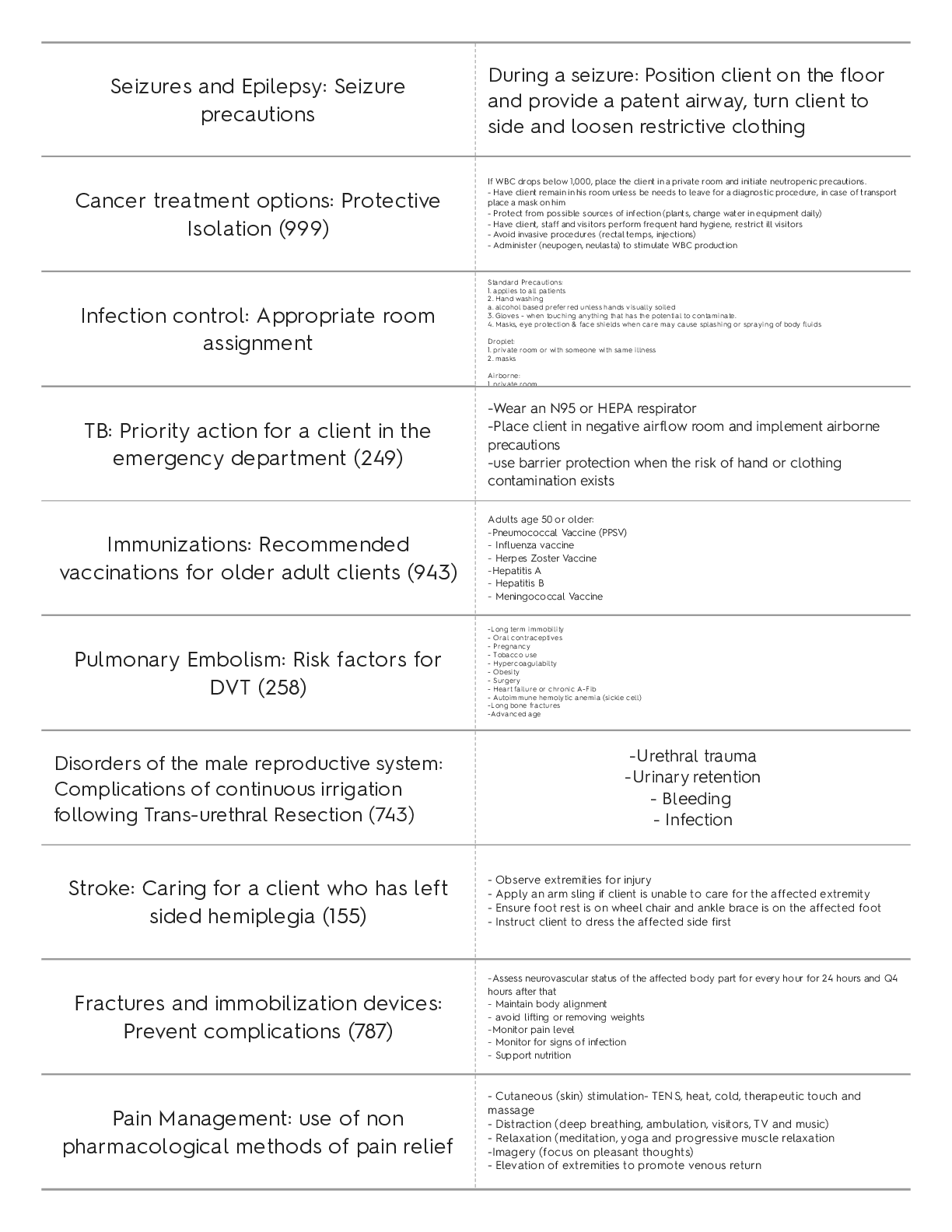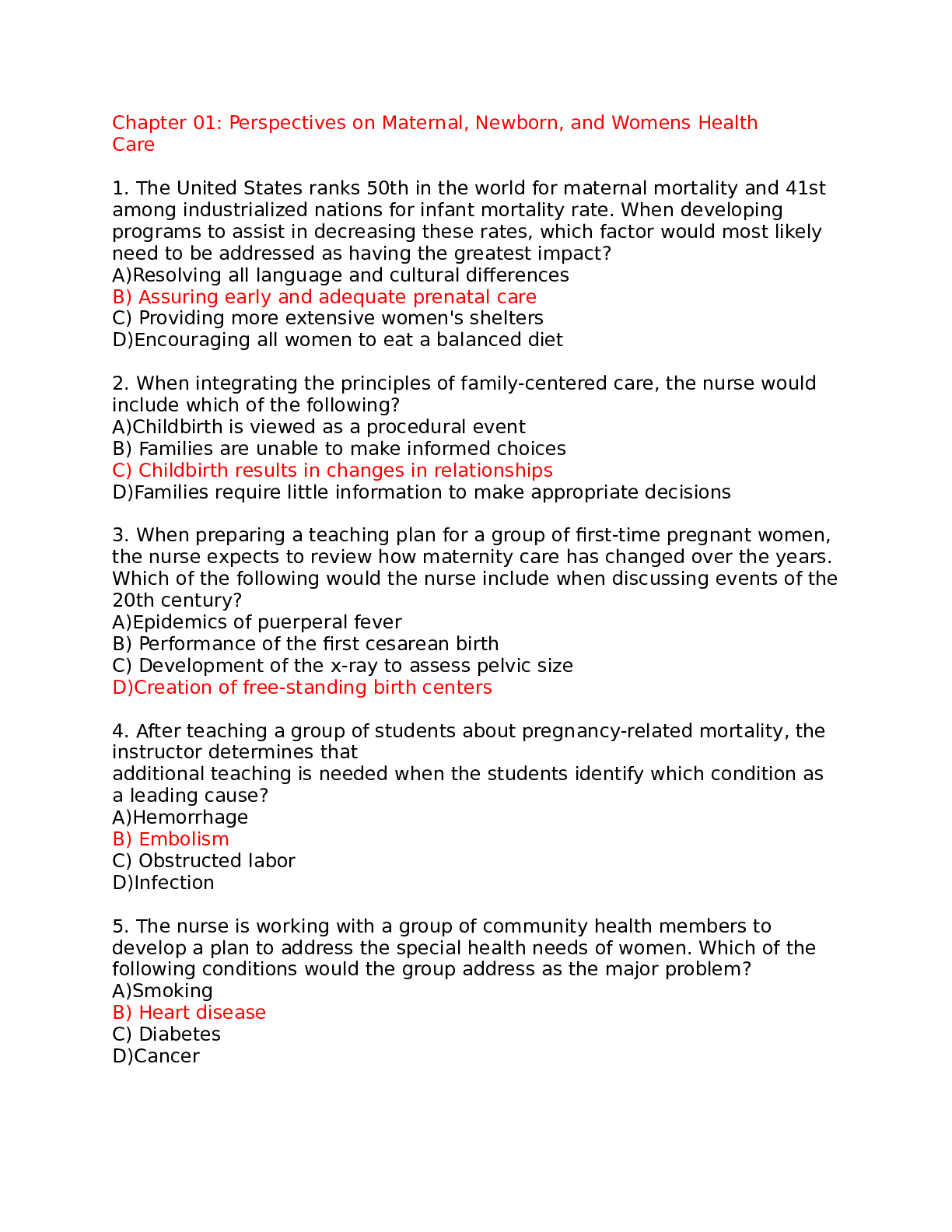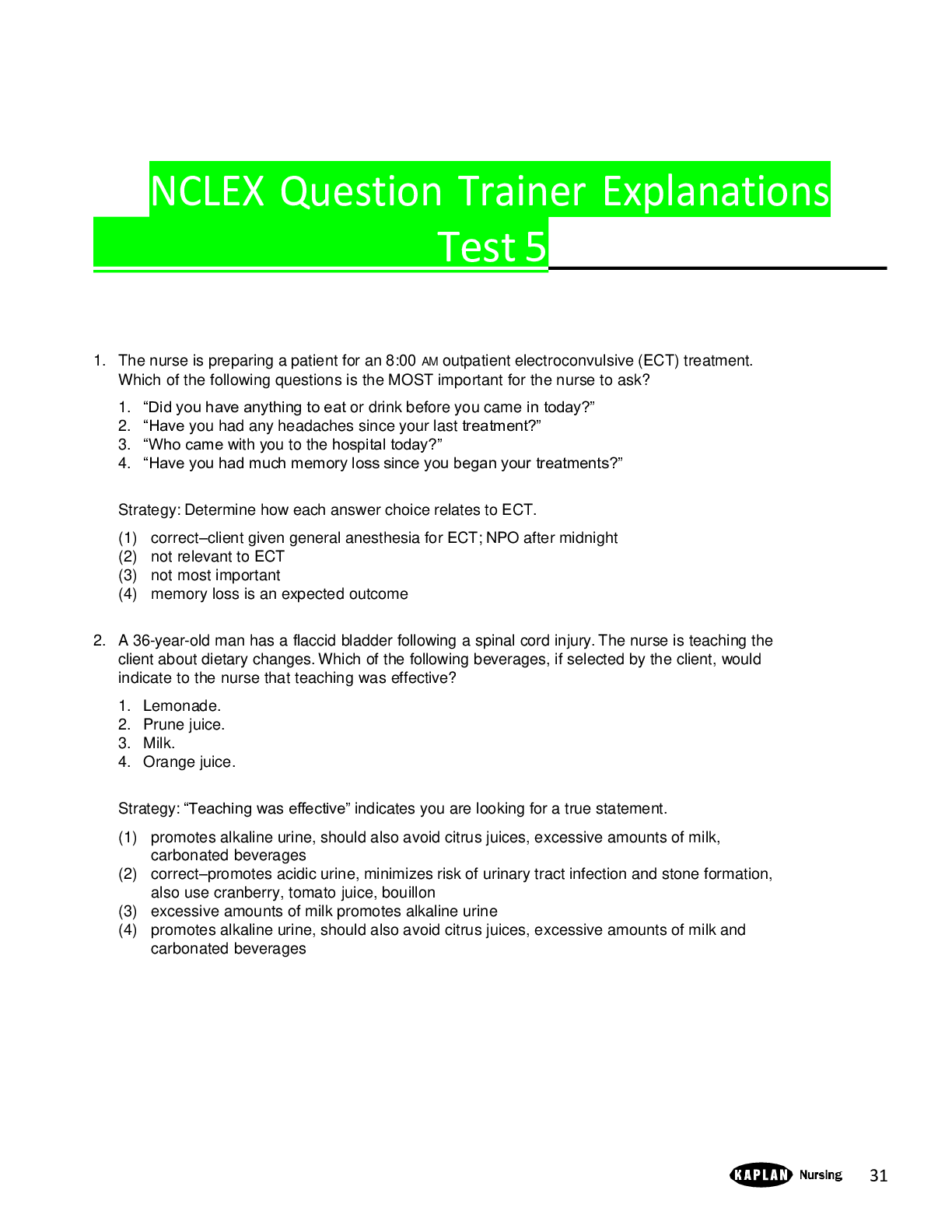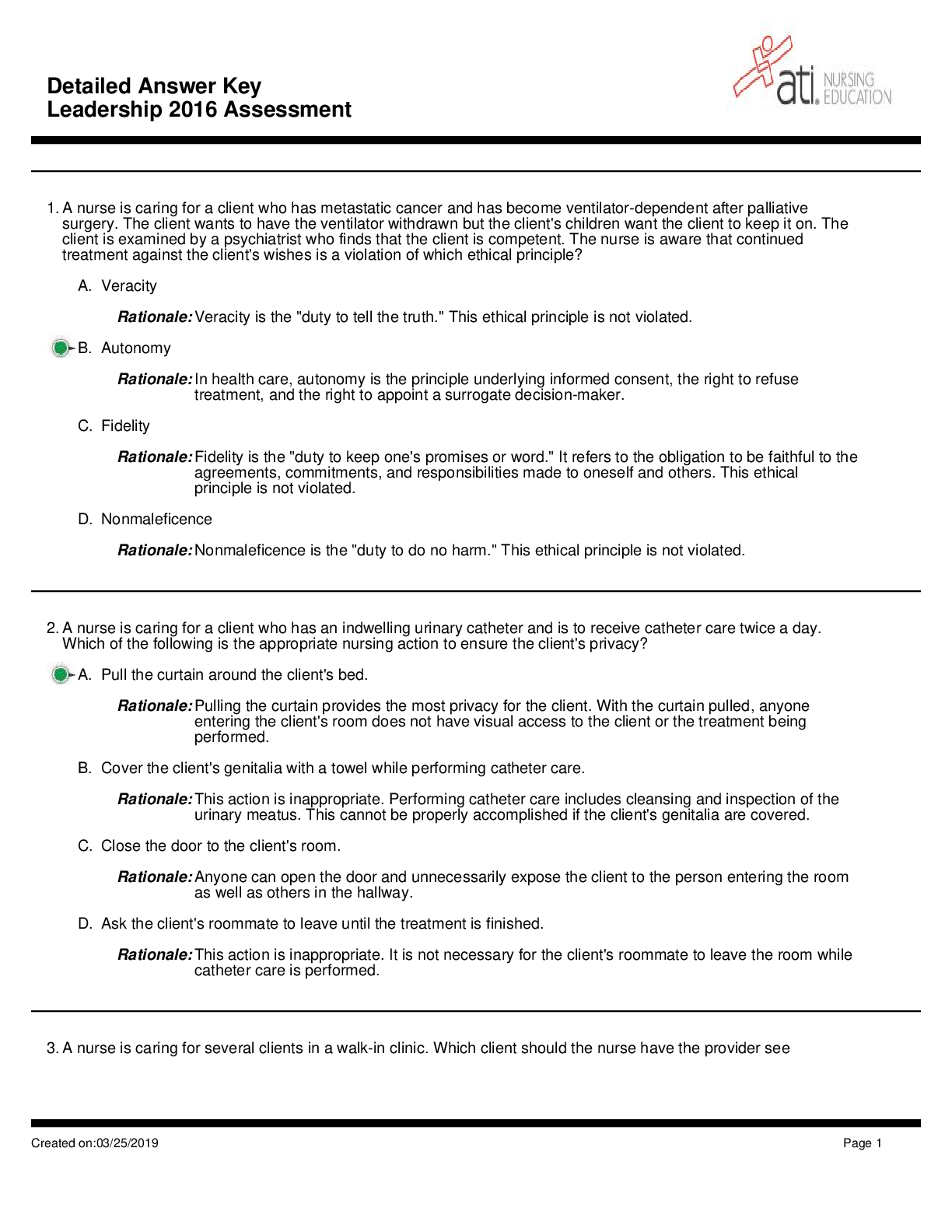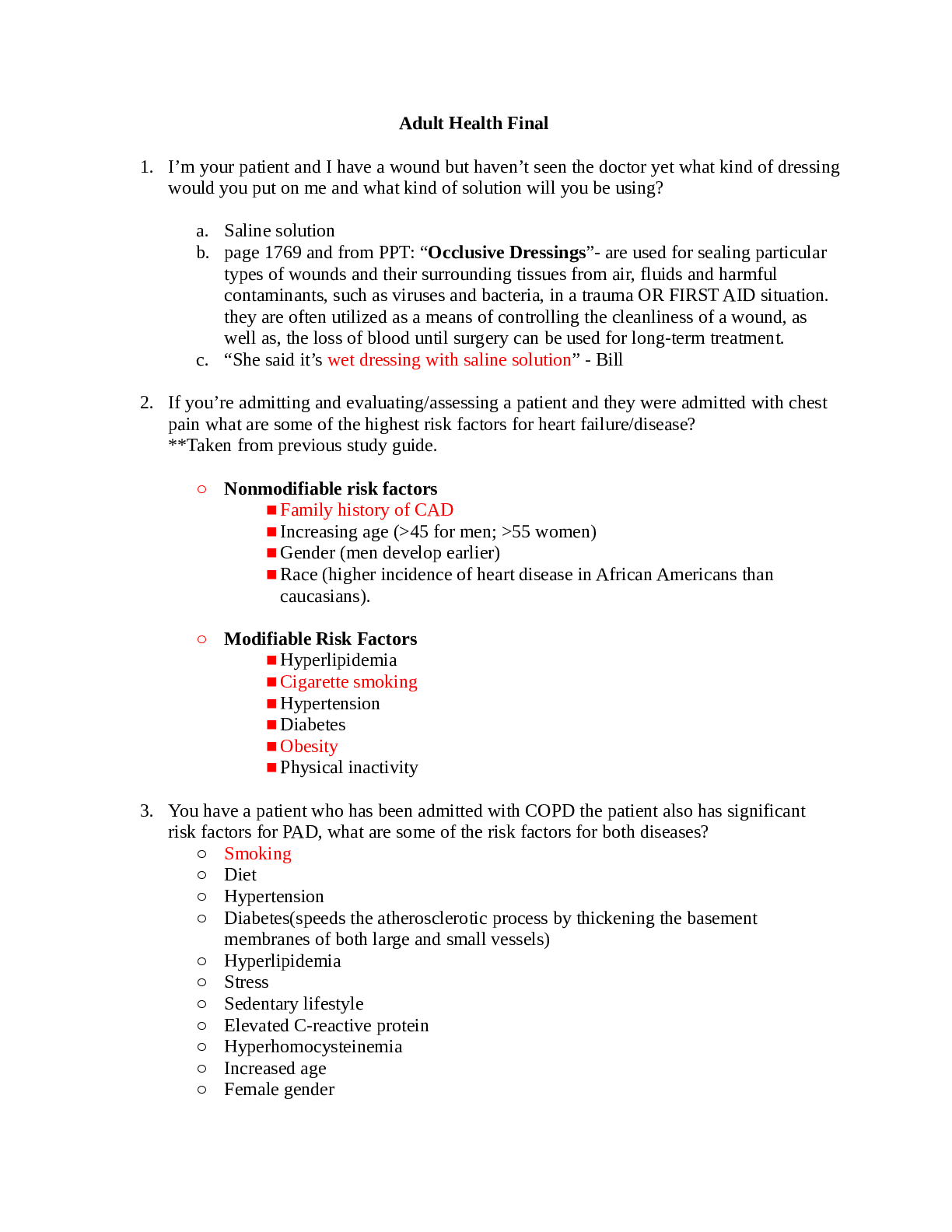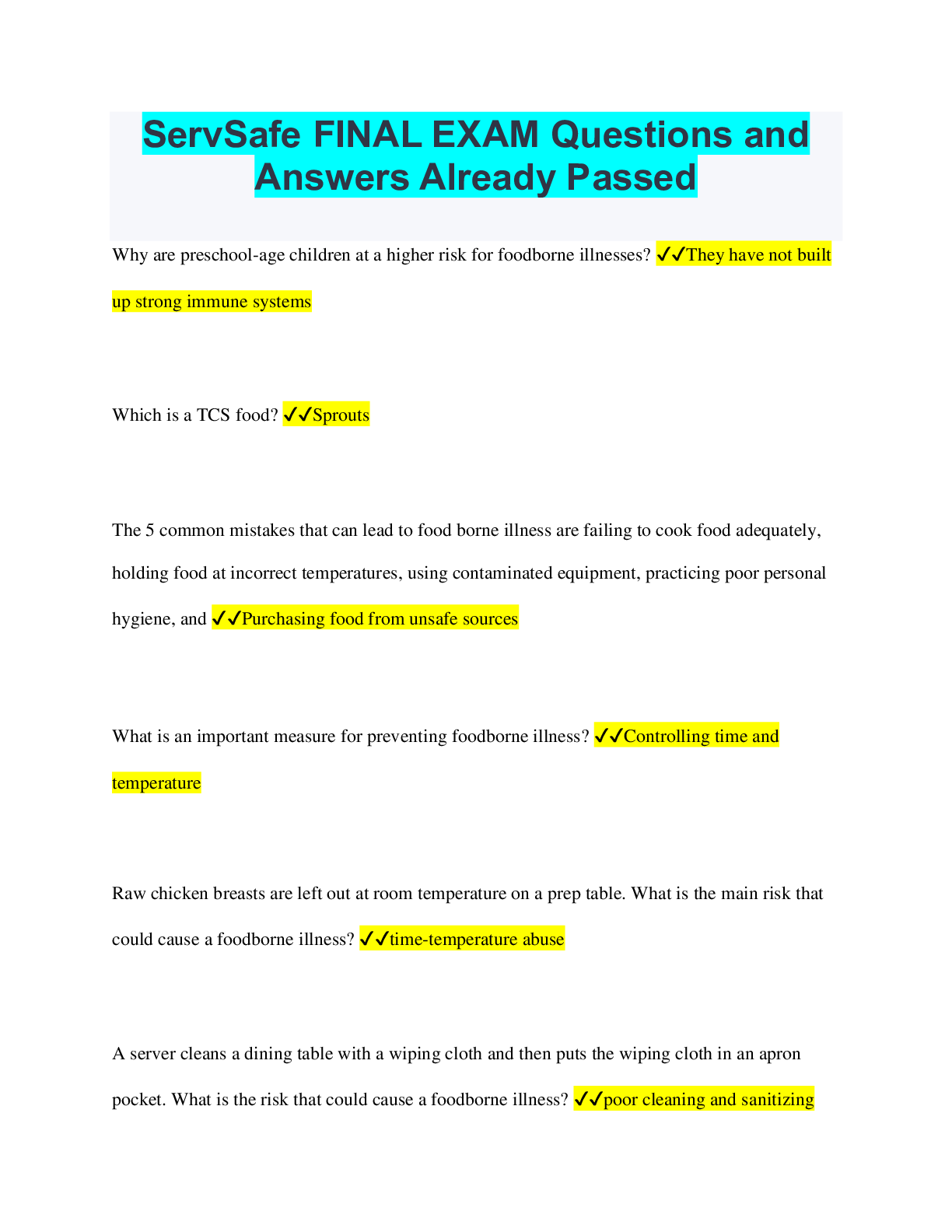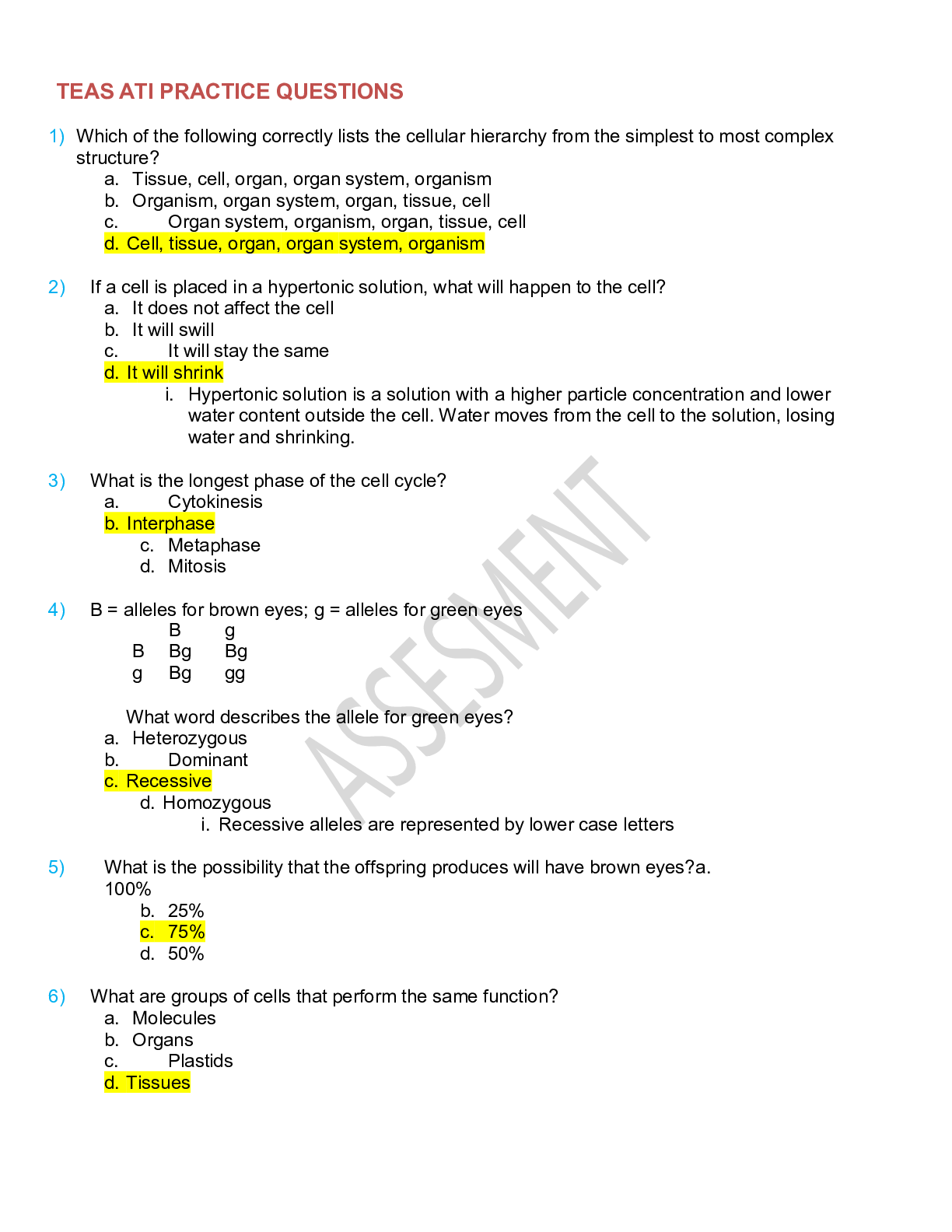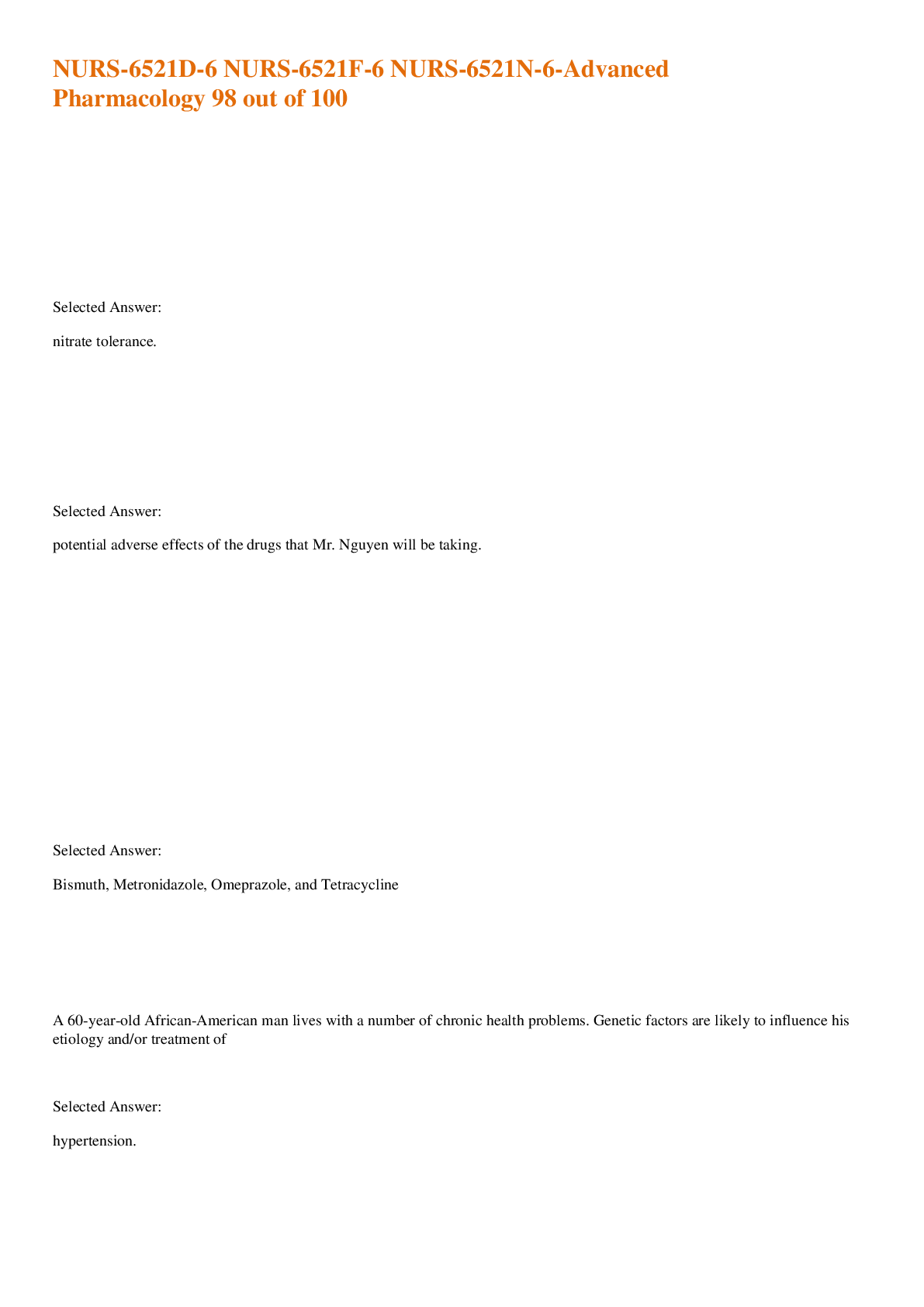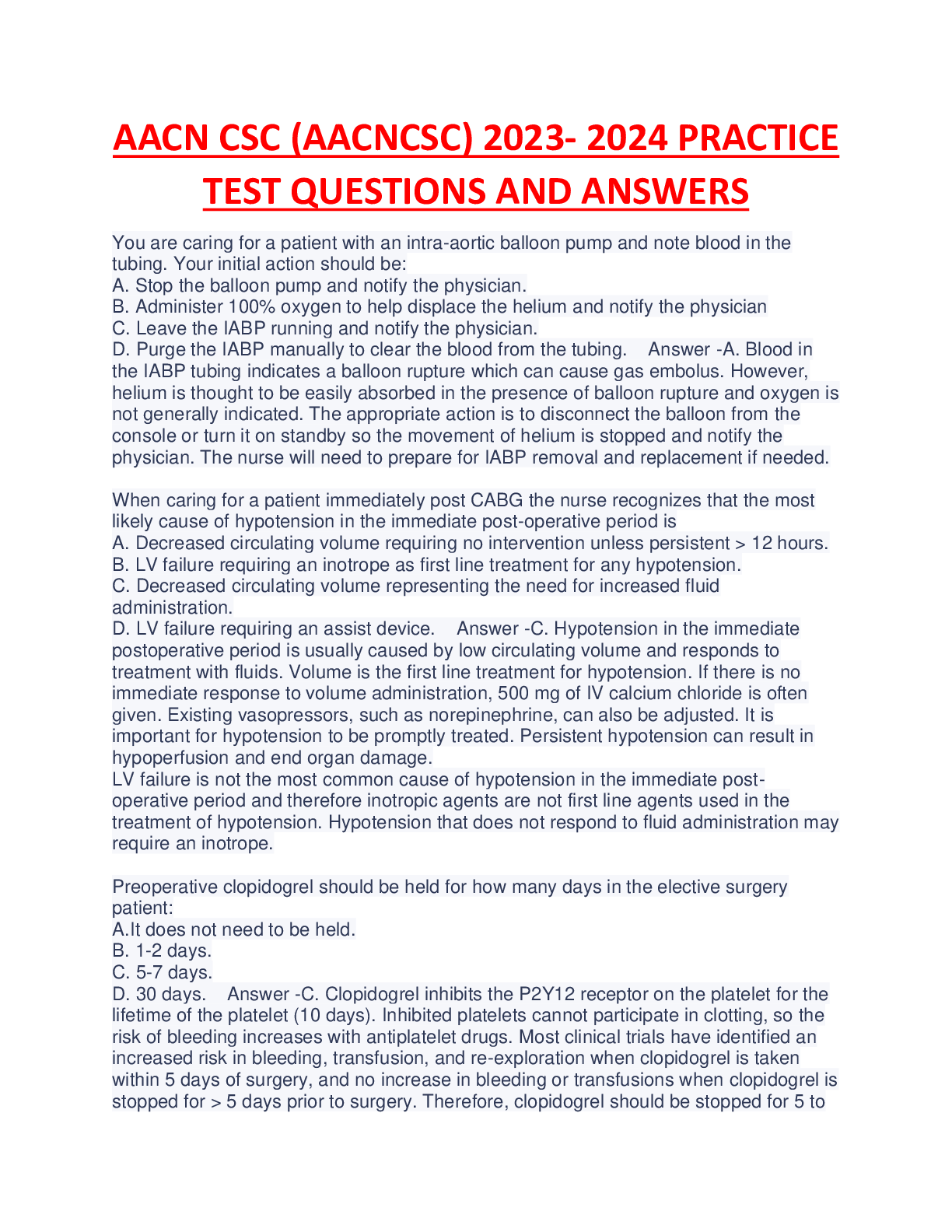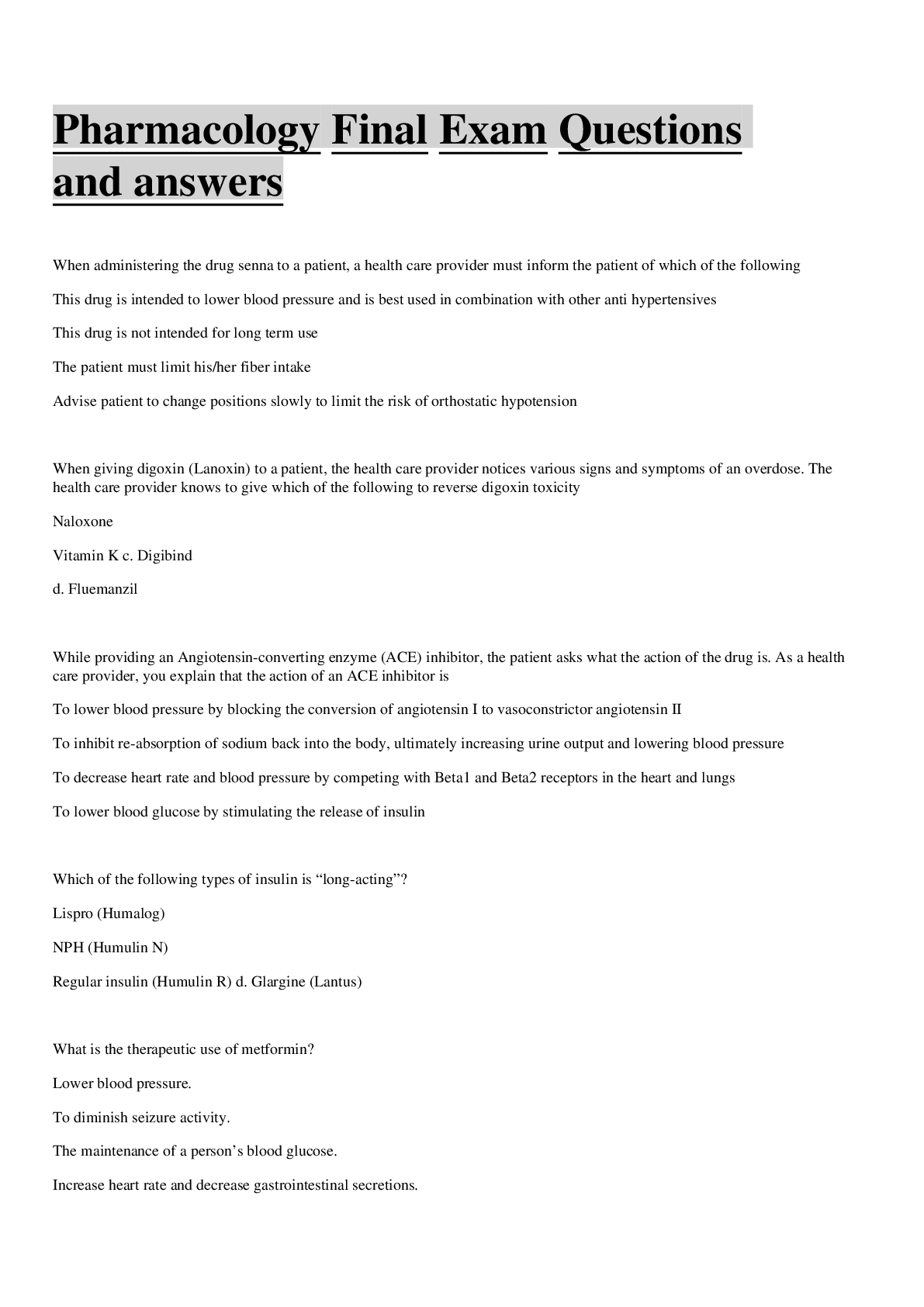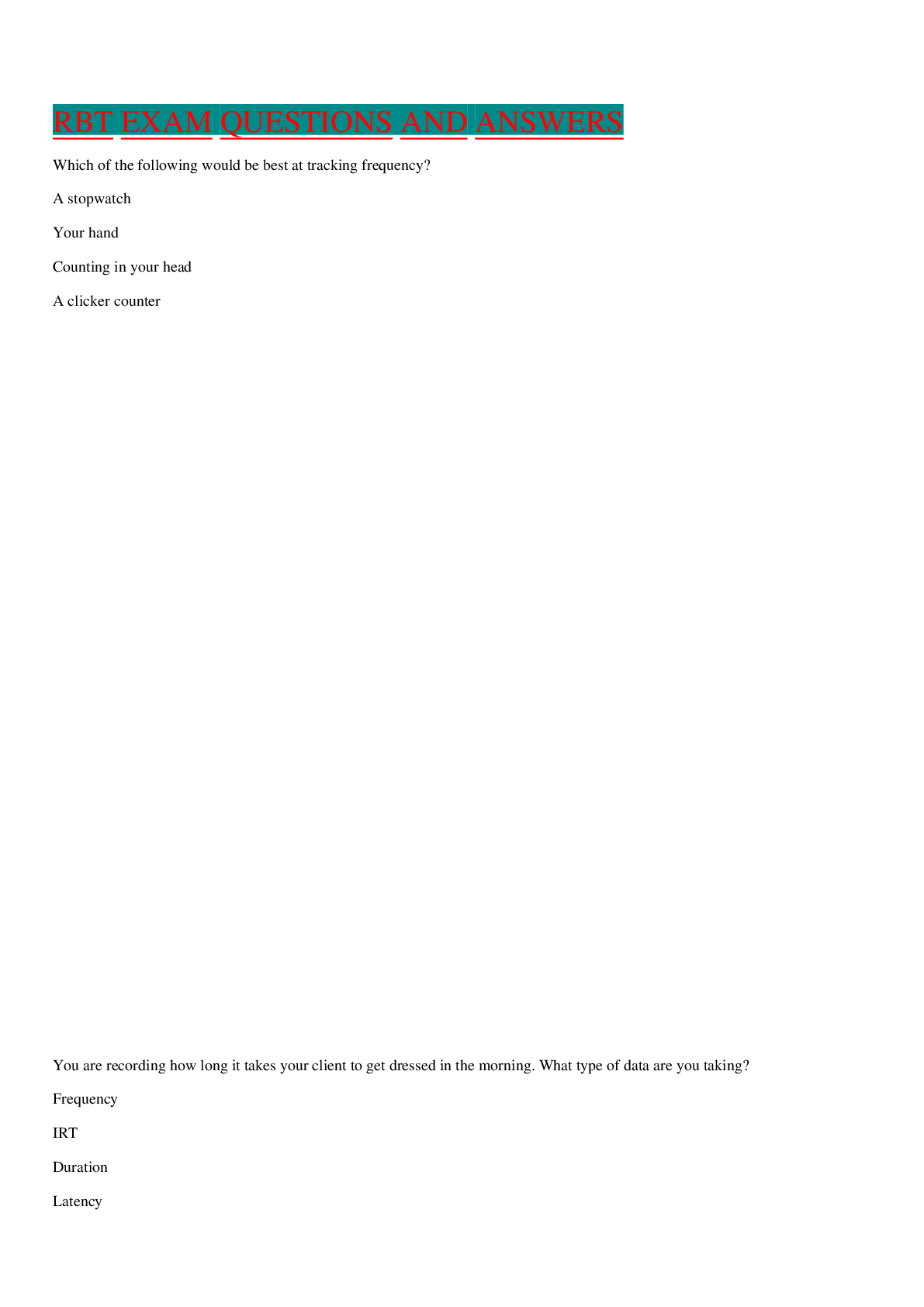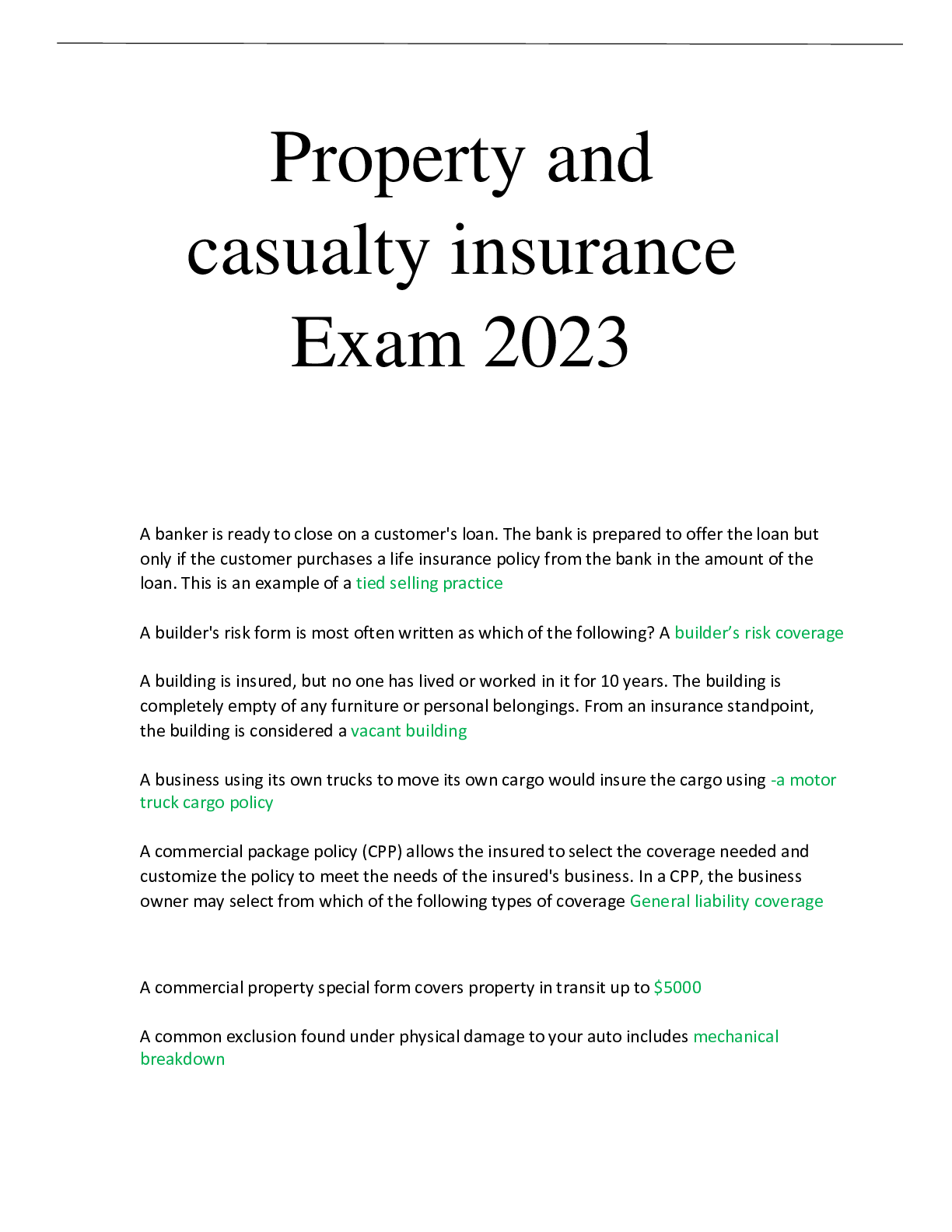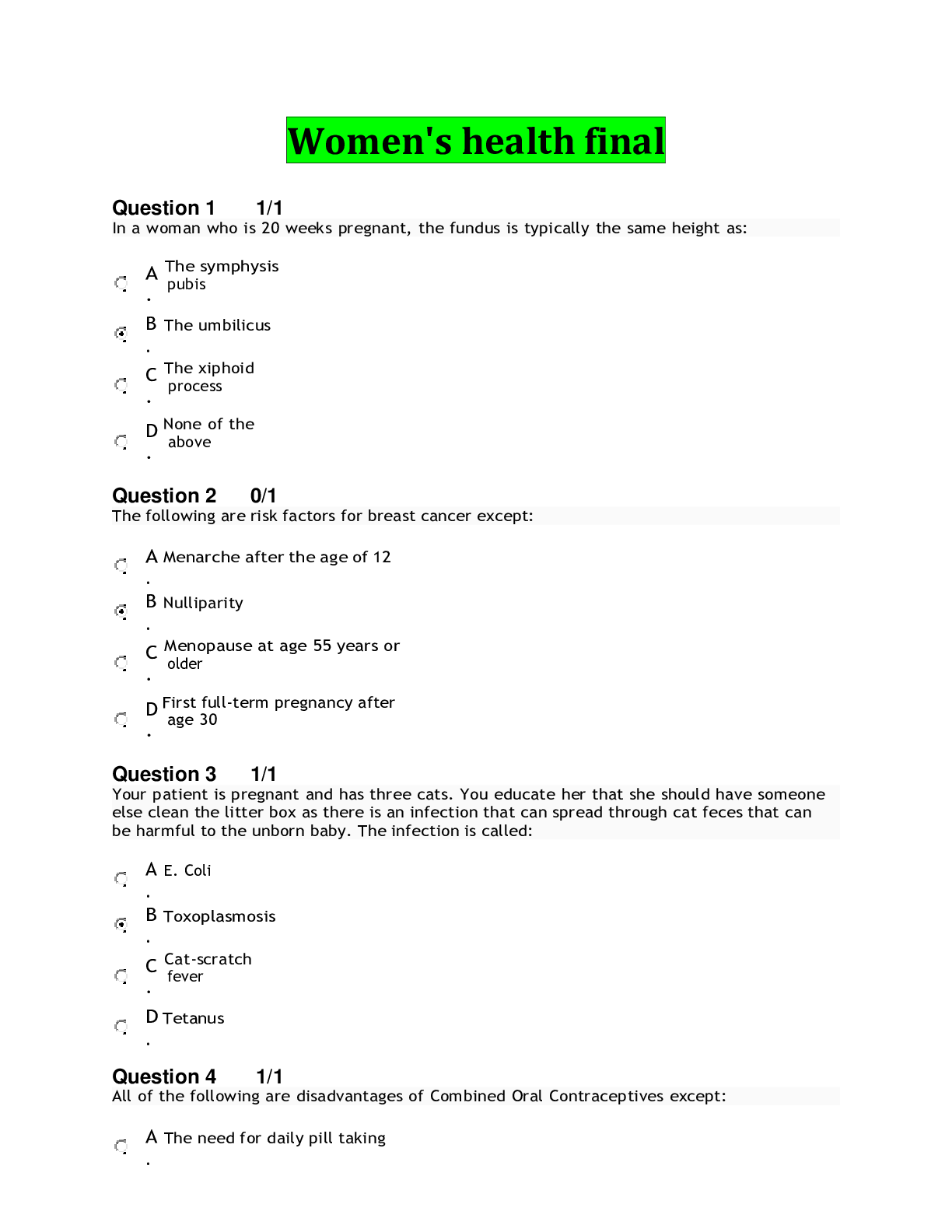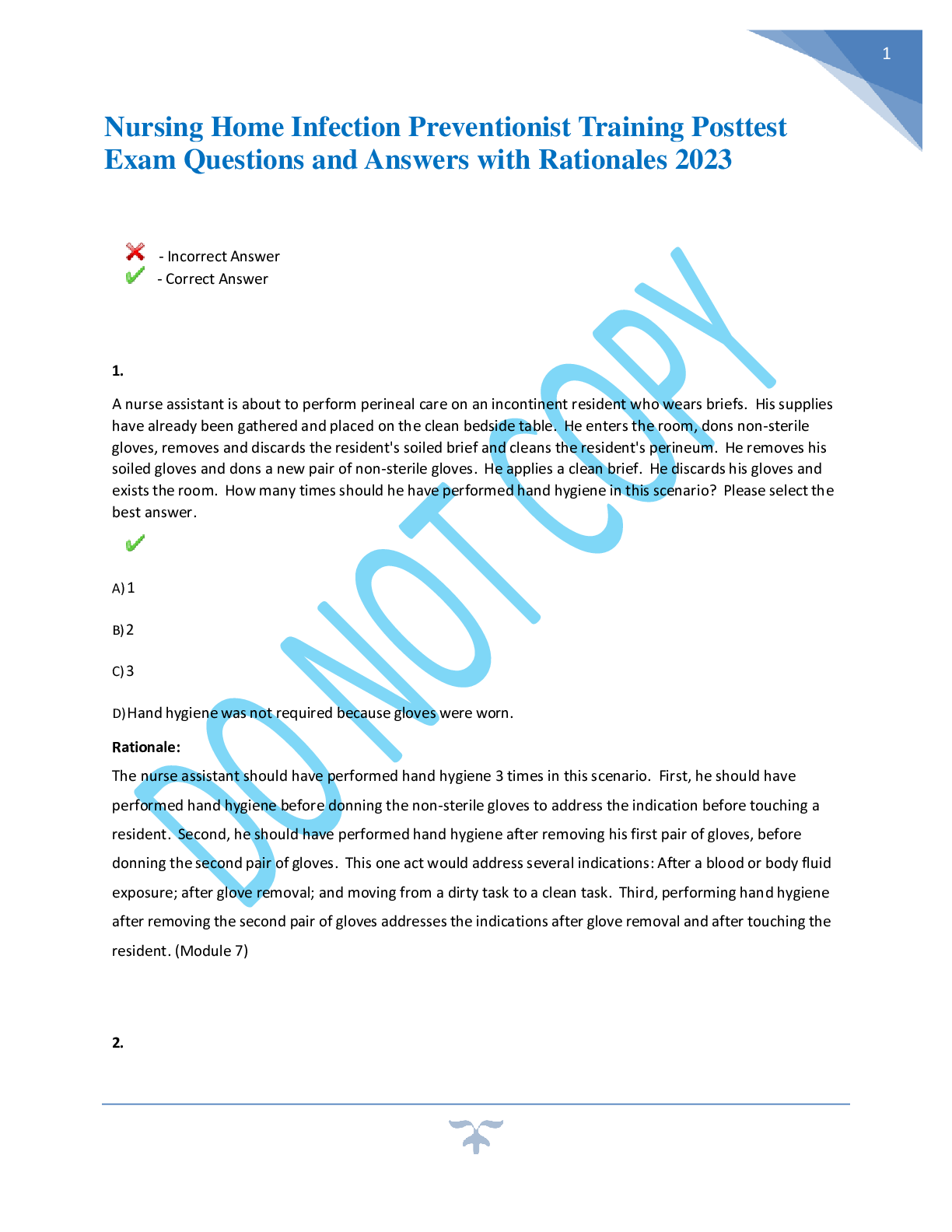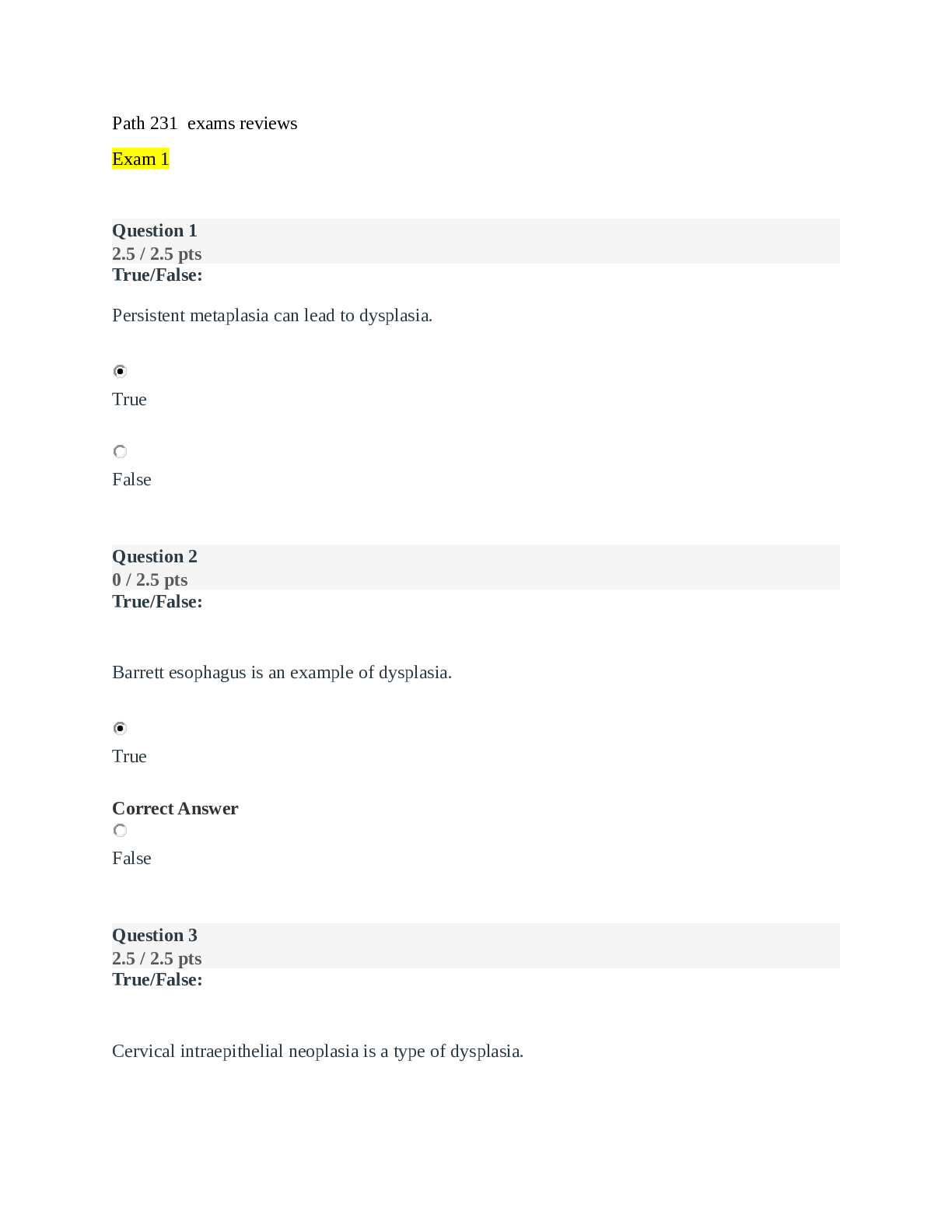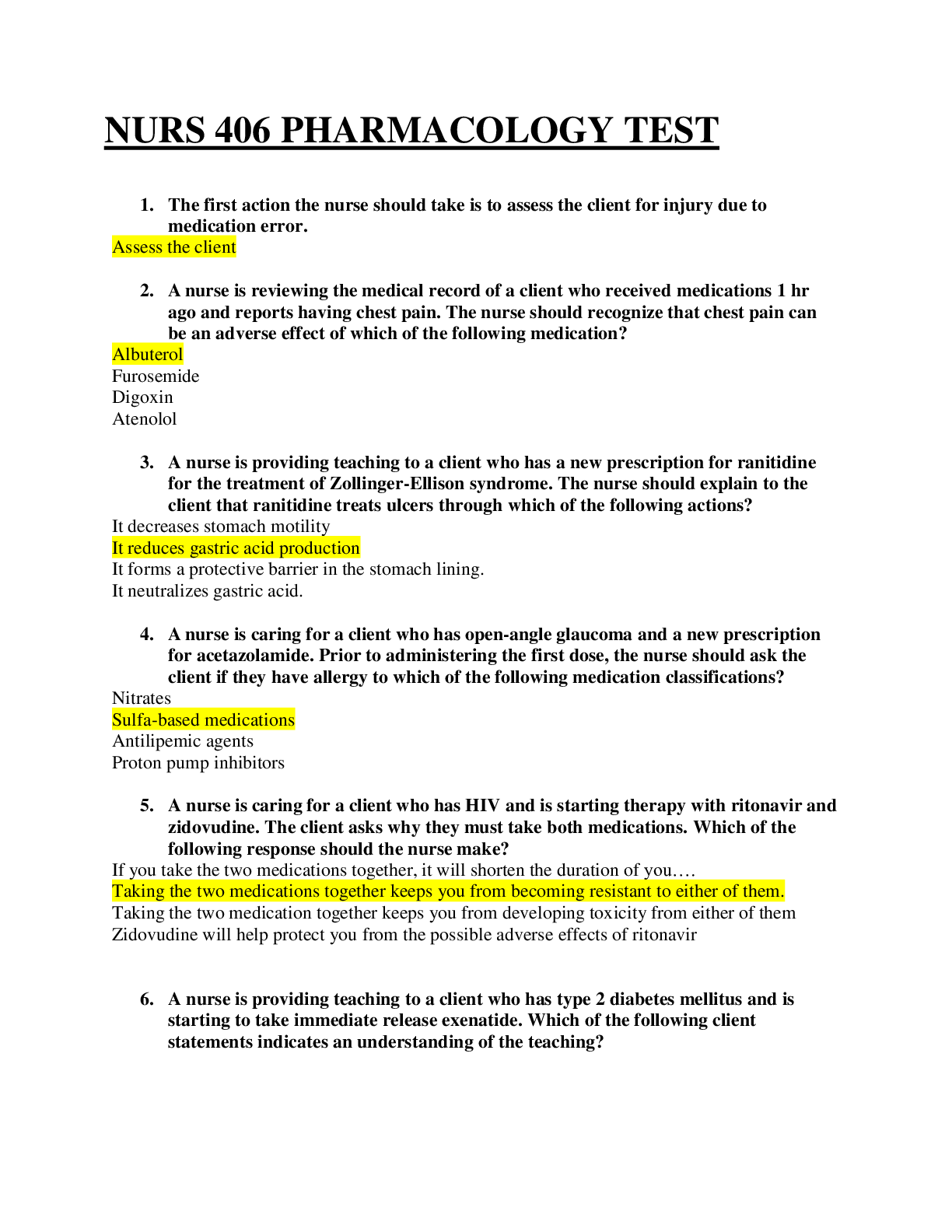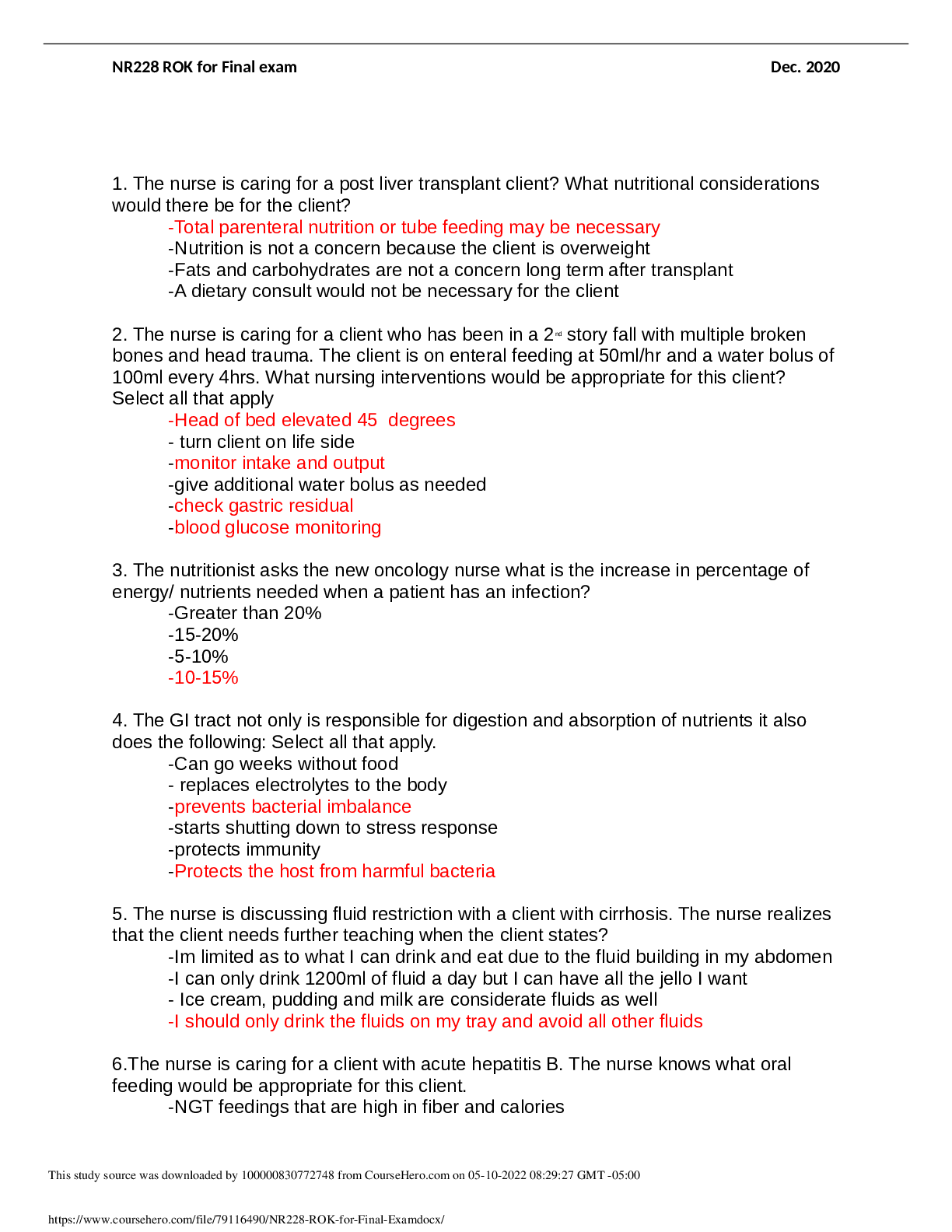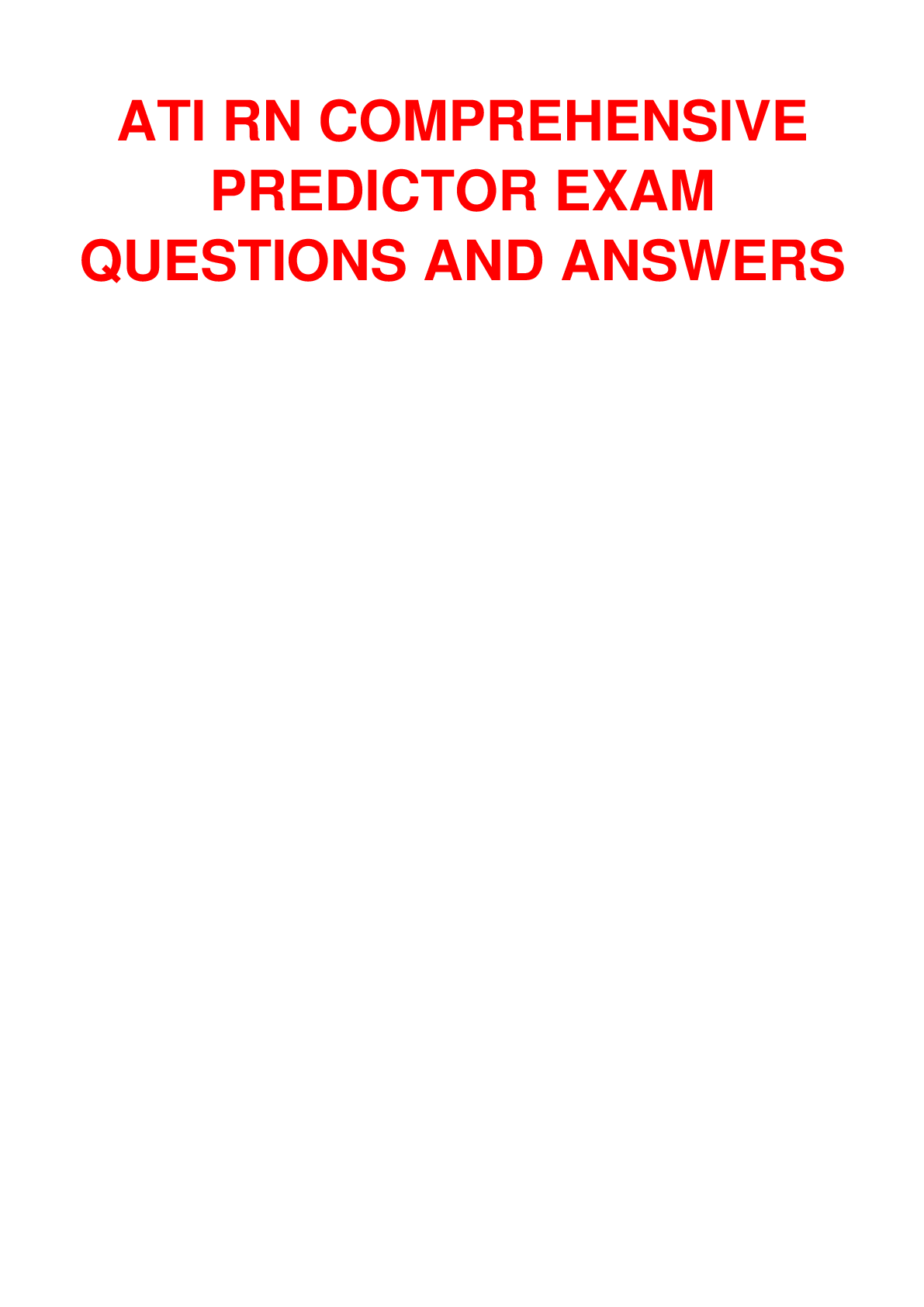ATI EXAM QUESTIONS AND ANSWERS DetailedAnswerKey
Document Content and Description Below
ATI EXAM QUESTIONS AND ANSWERS DetailedAnswerKey ⦁ A nurse is transcribing a client’s medication prescriptions and is having difficulty reading a written prescription by the provider. Which ... of the following nursing actions should the nurse take? ⦁ Clarify the prescription with the client’s family. Rationale: The nurse should not clarify the medication prescription with the client’s family, because this action could be a breach of confidentiality. ⦁ Interpret the prescription based on the client’s health history. Rationale: The nurse should not interpret the medication prescription based on the client’s health history, because incorrect information may result. ⦁ Ask the pharmacist for clarification of the prescription. Rationale: The nurse should not ask the pharmacist for clarification of the prescription, because incorrect information may result. Contact the provider to clarify the prescription. Rationale: The nurse should contact the provider for clarification of the prescription to confirm the correct interpretation of the prescription. ⦁ A nurse on a quality control committee is evaluating the results of recently implemented measures designed to reduce client medication errors. Which of the following methods should the nurse use to evaluate the success of the changes? ⦁ Establish a benchmark to identify a standard of performance. Rationale: A benchmark measures the practices of an organization against a best–performing organization in order to develop improvement of performance. It is used as a tool to determine the desired standard of performance. Compare the number of medication errors before and after the action was implemented. Rationale: Preimplementation and postimplementation statistics for medication errors will provide information to determine the success of the actions. ⦁ Provide the staff with a questionnaire to quantify staff satisfaction with the changes. Rationale: A questionnaire that determines staff satisfaction can provide a means of communication regarding the new practice, but it does not measure the success of the new measures. ⦁ Conduct a study about the time and money costs of implementing the change. Rationale: A study about the time and money costs of the effort is useful for comparing the success of the changes to the cost required to make them. However, this will not measure how successful the changes were in reducing medication errors. ⦁ A charge nurse is delegating tasks to nursing personnel on a 10-bed medical-surgical nursing unit. Which of the following assignments is an example of overdelegation? ⦁ Assigning two assistive personnel (AP) to ambulate all clients Rationale: Assigning two APs to ambulate 10 clients follows the rights of delegation and expectations of the APs. It is not an example of overdelegation. ⦁ Assigning a new graduate nurse to perform a wet-to-dry dressing change Rationale: Assigning a new graduate nurse to perform a wet-to-dry dressing change follows the rights of delegation and expectations of the nurse. It is not an example of overdelegation. Assigning the most efficient AP to perform glucometer monitoring for each client Rationale: Asking the most efficient AP to perform glucometer testing based on her efficiency in performing this task is an example of overdelegation. This can result in the AP becoming overworked and tired, thus decreasing productivity. ⦁ Assigning the most competent RN to perform a central line dressing change Rationale: Assigning the most competent RN to perform a central line dressing change follows the rights of delegation and expectations of the nurse. It is not an example of overdelegation. ⦁ A nurse on a medical unit is planning care for several clients. Which of the following clients should benefit most from the nurse acting as an advocate? ⦁ A client who has previously undergone a procedure that is to be performed for a second time Rationale: The nurse supports the client in this situation, but it is not an example of a client benefitting most from the nurse acting as an advocate. ⦁ A client who has been educated on treatment options and chooses alternative treatments Rationale: The nurse supports the client in this situation, but it is not an example of a client benefitting most from the nurse acting as an advocate. ⦁ A client who makes an informed decision not to participate in chemotherapy treatment Rationale: The nurse supports the client in this situation, but it is not an example of a client benefitting most from the nurse acting as an advocate. An older adult client who has no family and is uncertain about moving to assisted living Rationale: The nurse acts as an advocate by ensuring the client has correct information to make an appropriate decision in selecting needed services. This is an example of a client benefitting most from the nurse acting as an advocate. ⦁ A nurse is caring for a client who has a history of dementia. The client is alert and oriented to person, place, and time, and has advance directives. The client is scheduled for a procedure that requires informed consent. Which of the following persons should sign the informed consent? ⦁ The client's partner Rationale: Legal decisions regarding health care must be made by a competent person or the person holding the durable power of attorney. The client Rationale: If the client appears competent, and understands the procedure, the client can sign for informed consent. The nurse should verify that the client gives consent voluntarily, the signature on the consent is the client's, and the client appears competent. If the client were disoriented and not competent, the person who has durable power of attorney should sign informed consent. ⦁ The client's daughter, who is the primary caregiver Rationale: Although the primary caregiver cares for the client, legal decisions regarding health care must be made by a competent person or the person holding the durable power of attorney. Caring for a client does not give the client's daughter legal authority regarding health care decisions. ⦁ The client's son, who has a durable power of attorney Rationale: A durable power of attorney for health care is a legal document that designates an individual authorized to make health care decisions for a client who is unable. The client's son should be familiar with the client's wishes. ⦁ A public health nurse is assessing an older adult client who lives with a family member. The nurse identifies several bruises in various stages of healing. The client and family member explain that the bruises are a result of clumsiness. However, based on the distribution of the bruises, the nurse suspects abuse. Which of the following actions should the nurse take first? ⦁ Document the bruises in the client's chart. Rationale: The nurse should document the bruises in the client’s chart after providing care to comply with legal guidelines; however, there is another action the nurse should take first. Report the findings to a supervisor. Rationale: The greatest risk to this client is further injury from continued abuse; therefore, the first action the nurse should take is to report the findings to a supervisor. Nurses are required to report suspected cases of child and older adult abuse. ⦁ Provide the client with a crisis hotline number. Rationale: The nurse should provide the client and family with a crisis hotline number in case emergency help is needed; however, there is another action the nurse should take first. ⦁ Discuss respite care with the client’s family. Rationale: The nurse should discuss respite care with the client’s family to prevent caregiver role strain; however, there is another action the nurse should take first. ⦁ A nurse and an experienced licensed practical nurse (LPN) are caring for a group of clients. Which of the following tasks should the nurse delegate to the LPN? (Select all that apply.) ⦁ Provide discharge instructions to a confused client's spouse. Obtain vital signs from a client who is 6 hr postoperative. Administer a tap-water enema to a client who is preoperative. ⦁ Initiate a plan of care for a client who is postoperative from an appendectomy. Catheterize a client who has not voided in 8 hr. Rationale: Providing discharge instructions to a confused client's spouse is incorrect. The nurse is responsible for delegating a task to the person who has proper training and skill. Client education is the responsibility of the registered nurse.Obtaining vital signs from a client who is 6 hr postoperative is correct. Obtaining is a task that is appropriate to the education and skills of an LPN.Administering a tap-water enema to a client who is preoperative is correct. Administering a tap-water enema is a task that is appropriate to the education and skills of an LPN.Initiating a plan of care for a client who is postoperative from an appendectomy is incorrect. Planning care is the responsibility of the registered nurse.Catheterizing a client who has not voided in 8 hr is correct. Urinary catheterization is a task that is appropriate to the education and skills of an LPN. ⦁ A charge nurse is planning to conduct a performance appraisal of a staff member on her unit. Which of the following actions should the nurse take? ⦁ Inform the staff member of her appraisal time for that day prior to change-of-shift report. Rationale: The charge nurse should give the employee 2 to 3 days advance notice of the appraisal conference time so the staff member can be prepared for the interview. ⦁ Schedule the appraisal interview as early in the shift as possible. Rationale: The charge nurse should schedule the appraisal interview at a time when it is not busy at work and when it is convenient for the staff member so she can have time to fully participate in the conference. ⦁ Provide a chair directly across the desk for the staff member to sit in. Rationale: The charge nurse should arrange the chairs so they are side by side to denote collegiality. Placing the chairs across from one another denotes a power status position. Provide the staff member with a copy of the appraisal form in advance. Rationale: The charge nurse should ensure the staff member knows the standards by which her work will be evaluated and that she has a copy of the appraisal form. ⦁ A nurse has completed an informed consent form with a client. The client then states, “I have changed my mind and do not want to have the procedure done.” Which of the following actions should the nurse take? ⦁ Remind the client that a signed informed consent form is a legally binding document. Rationale: The client has the right to withdraw informed consent; therefore, informing the client the consent is a legal document is not an appropriate response. Notify the surgeon that the client wishes to withdraw informed consent for the procedure. Rationale: The client has the right to withdraw informed consent; therefore, the surgeon who is the one to obtain the informed consent should be notified of the request. ⦁ Inform the surgical team to cancel the client’s surgery. Rationale: The client has the right to withdraw informed consent; however, the surgeon who is the one to obtain the informed consent should be notified first to determine if the surgery will be cancelled. ⦁ Proceed with preparation of the patient for the surgical procedure. Rationale: The client has the right to withdraw informed consent; therefore, proceeding with the preparation for surgery is not an appropriate response. ⦁ A nurse checks with assistive personnel on the unit throughout the shift to determine if they are completing tasks. The nurse is demonstrating which of the following rights of delegation? ⦁ Right circumstances Rationale: The right circumstances include delegating tasks that do not require independent nursing judgment. ⦁ Right communication Rationale: The right communication includes providing clear explanations about the tasks, client outcomes, and when the delegate should report to the nurse. ⦁ Right person Rationale: The right person means delegating to the individual who is competent and qualified. D. Right supervision Rationale: The nurse is demonstrating the right supervision when she assesses how the tasks are being accomplished and if any improvements are needed. ⦁ A nurse intercepts a messenger at the nurses’ station who has a flower delivery for a client on the unit. As the nurse accepts the flowers, the messenger says, “I know Mrs. Welch from the neighborhood. What happened to her?” Which of the following responses should the nurse provide? ⦁ “You know it’s not appropriate for you to ask me that.” Rationale: This is a nontherapeutic automatic response that assumes that the messenger has knowledge of client confidentiality. This response belittles the messenger and minimizes his concerns. B. “It’s my responsibility to remind you that we have to respect our clients’ privacy.” Rationale: This therapeutic response provides clarification to the messenger that the hospital staff cannot disclose information about clients. C. “It’s a minor injury. I’m sure you’ll see her back in the neighborhood soon.” Rationale: This is a nontherapeutic response. The nurse may not provide health information about a client to anyone other than hospital staff who are directly involved in the client’s care. Sharing of information about a client violates the client’s right to privacy and confidentiality. D. “Oh, what lovely flowers. She will enjoy these.” Rationale: This is a nontherapeutic response which changes the subject, does not address the messenger’s concerns and offers the nurse’s personal opinion about the client’s enjoyment of the flowers. 12. A nurse enters a client’s room and finds the client pulseless. The family has requested a do-not-resuscitate (DNR) order from the provider, but he has not written the order yet. Which of the following actions should the nurse take? A. Call the emergency response team. Rationale: Unless the provider writes a DNR order, the nurse should make every effort to revive the client. The nurse should follow the facility’s protocol for enacting the emergency response procedure. ⦁ Seek immediate help from the risk manager. Rationale: The nurse does not have time to wait for a response from the risk manager. The nurse should follow the facility’s protocol for this type of situation. ⦁ Call the provider for a stat DNR order. Rationale: The nurse should follow the facility’s protocol for this type of situation. ⦁ Respect the family’s wishes and do nothing. Rationale: The nurse should follow the facility’s protocol for this type of situation. Without a DNR order, the nurse cannot follow the family’s wishes. ⦁ A nurse is teaching a class on torts. The nurse should instruct the class that administering an antibiotic medication to a competent client after the client has refused it is an example of which of the following torts? ⦁ Assault Rationale: Assault is the act of verbally threatening a client. A nurse who verbally threatens to give a medication to a client without the client’s consent is committing assault. ⦁ False imprisonment Rationale: False imprisonment is detaining a client against her will without legal warrant. A nurse who administers a chemical restraint without the client’s consent is committing false imprisonment. ⦁ Negligence Rationale: Battery Negligence is a breach of duty that results in harm to the client. A nurse who administers an incorrect medication to a client is committing professional negligence. Rationale: Battery is physical contact without the client’s consent. Administering a medication against a client’s wishes is an example of battery. ⦁ A charge nurse allows two nurses who are arguing about who gets to go to lunch first to go together. The charge nurse agrees to take care of both of the nurses' clients while they are at lunch. The charge nurse is demonstrating which of the following types of conflict management? ⦁ Avoiding Rationale: The charge nurse did not display avoiding, which is not to acknowledge or try to resolve the conflict. ⦁ Competing Rationale: The charge nurse did not display competing, which is when one person makes a quick or unpopular decision at the expense of another. ⦁ Compromising Rationale: The charge nurse did not display compromising, which is when all parties involved are willing to give up something in the resolution of the conflict. D. Cooperating Rationale: The charge nurse displayed cooperating, which is the resolution of the conflict by sacrificing. In this situation, it allowed both staff nurses to get what they wanted. ⦁ A charge nurse plans to use effective change strategies when implementing a change in a nursing procedure on the medical-surgical unit. Which of the following actions should the charge nurse take during the moving stage of change? ⦁ Assess the problem. Rationale: During the unfreezing stage, the charge nurse should assess the problem. ⦁ Use tactics to alert staff nurses that a change is needed. Rationale: During the unfreezing stage, the charge nurse should make the staff nurses aware that a change is needed. ⦁ Evaluate the effectiveness of the change. Rationale: During the refreeze stage, the charge nurse should evaluate the effectiveness of the change. D. Set a target date. Rationale: During the moving stage, the charge nurse should develop the plan for change and set the target date. ⦁ A nurse is prioritizing care for two clients at the start of the shift. The first client, who is 1 day postoperative following a partial bowel resection, requires a dressing change, total parental nutrition administration and reports a pain level of 6 on a scale from 0 to 10. The second client, who has a newly inserted percutaneous gastrostomy tube, requires a tube feeding, dressing change, and daily weight. Which of the following nursing actions should the nurse plan to complete first? A. Weigh the second client. Rationale: The nurse should weigh a client at the same time daily, but this is not the first action that the nurse should take. B. Obtain vital signs for both clients. Rationale: Using the nursing process as an organizing framework, the nurse should obtain vital signs on the two clients to determine if there are any emergent problems. C. Administer pain medication to the first client. Rationale: The nurse should complete a client assessment prior to administering pain medication. D. Change the dressings of both clients. Rationale: When obtaining vital signs, the nurse should also examine the condition of the dressing for signs requiring immediate action. Routine dressing changes are not the nurse’s priority action. 17. A nurse in the medical-surgical unit is assigning client care to a nurse who is floating from the PACU. The nurse should recognize that the float nurse is most qualified to care for which of the following clients? A. A client who is postoperative following a lobectomy and has a chest tube Rationale: According to evidenced-based practice, the nurse from the PACU is most qualified to care for the postoperative client. Nurses in the PACU care for clients with chest tubes after surgery. This is the right client, the right task, and the right circumstances for this nurse. ⦁ A client who is being discharged to a long-term care facility Rationale: The nurse should be capable of caring for this client. However, there is another client the nurse is more qualified to care for. A nurse who works in the PACU might not be familiar with the policy or procedure for a discharge to a long-term care facility. Since a report is given to the receiving facility, it is better to assign a nurse who is familiar with the client and their treatment. The five rights of delegation are not met with this client. ⦁ A client who needs teaching about insulin self-administration Rationale: The nurse should be capable of caring for this client. However, there is another client the nurse is more qualified to care for. Though all nurses are familiar with proper injection techniques and teaching, this is not a practice that a nurse in the PACU routinely participates in and is not the best assignment for the nurse. The five rights of delegation are not met with this client. ⦁ A client who needs teaching prior to initiating cardiac rehabilitation activities Rationale: The nurse should be capable of caring for this client. However, there is another client the nurse is more qualified to care for. Although this nurse should understand the concepts of cardiac rehabilitation, the PACU does not offer the opportunity to care for clients who require these services. The five rights of delegation are not met with this client. ⦁ A nurse notes a provider frequently arrives to the unit with bloodshot eyes and smells like alcohol after lunch. Which of the following actions should the nurse take? ⦁ Counsel the provider to determine the cause of the substance abuse. Rationale: The responsibility of the nurse is to protect clients from injury. It is not the responsibility of the nurse to counsel the provider. ⦁ Encourage clients to change to a different provider. Rationale: Encouraging clients to change services based on assumptions is defamation and could result injury to the reputation of the provider. The nurse could be sued for this action. ⦁ Inform the state medical board for an immediate investigation. Rationale: It is the responsibility of hospital management and administration to follow up with any state licensure boards in cases of impairment or client negligence or harm. D. Notify the nursing supervisor of the concerns. Rationale: The nurse should notify hospital or nursing management of the concerns, and then ensure client safety. It is the responsibility of management to conduct an investigation. Client safety is the responsibility of the nurse. 19. A nurse manager is reviewing information about critical pathways with the unit nurses. Which of the following information should the nurse manager include? A. "Critical pathways should include evidence-based interventions." Rationale: Research evidence indicates that standardized care backed by evidence based practice improves client outcomes. Therefore, the critical pathway should be created using evidence-based interventions and treatment. ⦁ "Critical pathways replace nursing care plans." Rationale: Critical pathways are multidisciplinary and do not include detailed nursing interventions; therefore, they do not replace nursing care plans. ⦁ "Critical pathways are used for clients who have rare medical diagnoses." Rationale: Critical pathways are developed for clients who have common medical diagnoses, such as heart failure. ⦁ "Critical pathways reduce the amount of paperwork involved in client care." Rationale: Critical pathways increase the amount of paperwork involved in client care, but are still viewed as being advantageous because they improve client care and decrease the cost of care. 20. A nurse on a pediatric unit is caring for four clients. The nurse should recommend an interdisciplinary client care conference for which of the following clients? A. A client who was diagnosed with cystic fibrosis and has a distended abdomen. Rationale: Cystic fibrosis is a genetic disease that requires the management of respiratory, gastrointestinal, and endocrine problems. A multidisciplinary approach is needed to promote quality of life for this client. ⦁ A client who is 10 hr postoperative from an appendectomy. Rationale: Recovery from an appendectomy is usually rapid and without complications; therefore, the nurse should not recommend an interdisciplinary conference for this client. ⦁ A client who is 6 hr postoperative from a tonsillectomy. Rationale: Although the client is at risk for bleeding following the procedure, most clients recover fully in 1-2 weeks. Therefore, the nurse should not recommend an interdisciplinary conference for this client. ⦁ A client who was diagnosed with acute diarrhea from the Norovirus. Rationale: Acute diarrhea from the Norovirus is usually self-limiting. Therefore, the nurse should not recommend an interdisciplinary conference for this client. ⦁ A nurse is applying wrist restraints to a client who is confused and attempting to pull out a chest tube. Which of the following actions should the nurse taking when using restraints? ⦁ Ensure that 1 finger breadth of space is between the client’s wrists and the restraint. Rationale: The nurse should ensure that there are 2 finger breadths of space between the client’s wrists and the restraints. ⦁ Secure the restraints to the side rails. Rationale: The nurse should tie the restraints to a part of the bed frame that moves when the head of the bed is raised or lowered. ⦁ Remove the restraint to check integrity of the skin every 4 hr. Rationale: The nurse should remove the restraints at least every 2 hr to check the integrity of the skin. D. Tie the restraint using a quick release knot. Rationale: The nurse should use a half bow (clove hitch, quick release) knot that does not does not tighten and can be removed quickly. 22. A nurse is interviewing a female client who is Hispanic. The client's partner answers the questions and states, "She speaks only a little English." Which of the following actions should the nurse take? A. Arrange to complete the assessment with only the client and a translator present. Rationale: As a client advocate, the nurse should provide a trained interpreter to translate for the client. It is critical to obtain assessment information directly from the client in order to protect the client's personal health information and collect an accurate history. ⦁ Ask the client's partner to translate questions and answers for the client. Rationale: The nurse should not use a family member as an interpreter for the client. This option does not demonstrate advocacy for the client because it does not protect the client's confidentiality. The client might not wish the family member to know about her health history and does not ensure that accurate information is obtained. ⦁ Ask a male student nurse to translate for the client. Rationale: Unless the student nurse is trained as an interpreter, he should not interpret for the client. The client might feel embarrassed using a male interpreter. ⦁ Use an internet website ending in.com to translate for the client. Rationale: An internet website ending in.com is a commercial website and can contain inaccurate information. This should not be used to translate an assessment history for a client. ⦁ A nurse is giving change-of-shift report using SBAR to the oncoming nurse on a client who has a traumatic brain injury. Which of the following information should the nurse include in the background segment of SBAR? ⦁ Glasgow results Rationale: The nurse should include the Glasgow coma scale under the assessment segment of SBAR. ⦁ Intracranial pressure readings Rationale: The nurse should include intracranial pressure readings under the assessment segment of SBAR. C. Code status Rationale: The nurse should report the client’s current code stats in the background segment of SBAR. D. Plan of care changes for upcoming shift Rationale: The nurse should include any changes to the plan of care for the next shift under the recommendation segment of SBAR. ⦁ A community health nurse is reviewing information about infectious diseases with the nurses on her team. The nurse should remind the team that which of the following diseases are included in the list of nationally notifiable infectious diseases? (Select all that apply.) A. Trichomonas vaginalis B. Chlamydia C. Gonorrhea D. Chancroid E. Candidiasis albicans Rationale: Trichomonas vaginalis is a sexually transmitted infection that occurs in women more often than men, but it is not on the list of nationally notifiable infectious diseases. Chlamydia is a sexually transmitted infection. When a client is diagnosed with chlamydia, the public health department is notified so that sexual partners can be notified and treated. Gonorrhea is a sexually transmitted infection. When a client is diagnosed with gonorrhea, the public health department is notified so that sexual partners can be notified and treated. Chancroid is a sexually transmitted infection. When a client is diagnosed with chancroid, the public health department is notified so that sexual partners can be notified and treated. Candidiasis albicans is a yeast infection which can affect the vagina, but it is not on the list of nationally notifiable infectious diseases. 25. A nurse is receiving a provider’s prescription for a client via telephone. Which of the following actions should the nurse take to ensure the accuracy of the telephone prescription? (Select all that apply.) A. Repeat the order back to the provider. B. Question any part of the order that is unclear or inappropriate. C. Transcribe the order into the client’s health record. D. Obtain the provider’s signature within 8 hr. E. Implement a recorded order message if the nurse can hear and understand it clearly. Rationale: Repeat the order back to the provider is correct. The nurse should read the order back and have the provider verbally confirm that it is correct.Question any part of the order that is unclear or inappropriate is correct. The nurse should question any part of the prescription or an order that is unclear or inappropriate. This is essential for any verbal or written prescription or order.Transcribe the order into the client’s health record is correct. The prescription should be entered in the health record as it is obtained and verified.Obtain the provider’s signature within 8 hr is incorrect. Although the policy may vary with each facility, the usual rule is to obtain the provider’s signature within 24 hr.Implement a recorded order message if the nurse can hear and understand it clearly is incorrect. If a provider leaves a recorded order message, the nurse should call the provider and obtain the prescription verbally over the telephone. ⦁ A nurse is triaging clients in an urgent care clinic. Which of the following clients should the nurse have the provider care for immediately? ⦁ An adolescent female client who is belligerent and has slurred speech Rationale: This client is displaying the effects of excessive alcohol intake and needs care. However, there is another client who has a higher priority need and should be cared for by the provider first. ⦁ A toddler who has a laceration on his forehead and is screaming Rationale: The nurse should apply pressure to the site of laceration and work with the parent to decrease the toddler’s anxiety. However, there is another client who has a higher priority need and should be cared for by the provider first. C. A middle adult male who is diaphoretic and reports epigastric pain Rationale: When using the urgent vs. nonurgent approach to client care, the nurse should determine that caring for this client is the highest priority because diaphoresis and epigastric pain are manifestations of an acute myocardial infarction. D. A young adult with a painful sunburn of his face and arms Rationale: A sunburn is a superficial burn and the client needs to be cared for by the provider. However, there is another client who has a higher priority need and should be cared for by the provider first. 27. A nurse is planning care for a client who has anorexia nervosa. The nurse should make which of the following client goals the priority? A. Attain a weight that is greater than the 75th percentile for age and height. Rationale: When using Maslow’s hierarchy of needs, the nurse should determine the priority goal is to meet the physiological need for adequate nutrition. This means working with the client to attain an increase in weight. ⦁ Make positive statements about improvements in body image. Rationale: Making positive statements about improvement in body image is important because the client needs to attain positive self-esteem; however, there is another goal that is the priority. ⦁ Feel in control of her behavior. Rationale: Having the client feel she is in control of her behavior is important because the client needs to attain the goal of safety; however, there is another goal that is the priority. ⦁ Identify changes within the family unit that promote the client’s autonomy. Rationale: The client needs to identify changes that promote autonomy because it is important for the client to attain the goal of love and belonging; however, there is another goal that is the priority. ⦁ A nurse is caring for four clients who are postoperative from surgery 24 hr ago. At 1200 the nurse assesses the clients. Which of the following clients is the nurse’s priority? ⦁ A client who has a prescription for insulin and his premeal capillary blood glucose was 110 mg/dL and his post-meal capillary blood glucose is now 160 mg/dL Rationale: Both blood glucose levels are within the expected reference range. This client is stable; therefore, he is not the nurse’s priority. ⦁ A client whose wound drainage at 0800 was sanguineous and now it is serosanguineous Rationale: A change in the color of wound drainage from sanguineous to serosanguineous is an expected finding for a client who is 24 hr postoperative from surgery. Therefore, this client is not the nurse’s priority. ⦁ A client who reports pain as 4 on a scale of 1 to 10 at 0800 now reports pain as 6 Rationale: The nurse should ask the client to rate his pain on a scale of 0 to 10 and provide care to manage the client’s pain. However, this client is not the nurse’s priority. D. A client whose blood pressure at 0800 was 138/86 mm Hg and at 1200 is 106/60 mm Hg Rationale: A client who is postoperative is at risk for hemorrhage. A blood pressure decrease of 15 to 20 points is significant. This client is unstable; therefore, this client is the nurse’s priority. ⦁ A client commits suicide in an acute mental health facility. Which of the following is the priority intervention for staff following this incident? ⦁ Provide professional counseling for staff members. Rationale: This is an appropriate intervention. However, it is not the priority when taking the nursing process approach to client care, as assessment of staff should be done before providing counseling. ⦁ Change policies for staff observation of clients who are suicidal. Rationale: This is an appropriate intervention. However, it is not the priority when taking the nursing process approach to client care. An analysis of current policies needs to be done before changes are made. C. Identify cues in the client’s behavior that might have warned them that he was contemplating suicide. Rationale: Identifying cues in the client’s behavior is the priority intervention when taking the nursing process approach to client care. Assessment is the first step in dealing with a situation. D. Give the family an opportunity to talk about their feelings. Rationale: Rationale D. This is an appropriate intervention. However, it is not the priority when taking the nursing process approach to client care. The family needs ongoing opportunities to process their feelings. ⦁ A nurse is preparing to discharge a client who has an abdominal wound that is healing by secondary intention. Which of the following actions is the nurse's priority? A. Instruct the client about home disposal of contaminated dressings. Rationale: The nurse should instruct the client about home disposal of contaminated dressings to reduce the risk of spreading potentially infectious material to the environment or to others. However, another action is the priority. B. Schedule a follow-up visit by a home health nurse for dressing changes. Rationale: The greatest risk to this client is injury from a wound infection. Therefore, the priority action the nurse should take is to schedule a follow-up visit by a home health nurse for dressing changes. Wounds healing by secondary intention are open and have edges that are not approximated, which increases the risk for infection. C. Provide a dietary list of foods which promote wound healing. Rationale: The client is at risk for impaired wound healing due to inadequate nutrition. However, another action is the priority. Adequate nutritional intake will promote wound healing. The client's diet should include foods high in fluids, protein, vitamin A, vitamin C, and zinc. D. Establish a follow-up appointment with the client's provider. Rationale: The nurse should schedule a follow-up appointment with the client's provider to monitor the client and assess healing. However, another action is the priority. 31. A nurse finds that a client did not receive a scheduled dose of furosemide (Lasix). Which of the following should the nurse include in the incident/variance report? (Select all that apply.) A. The date of the incident B. The name of the provider who prescribed the medication C. The potential adverse effects of the medication D. The time the client was to receive the medication E. The client's vital signs Rationale: The date of the incident is correct. When a nurse discovers a medication error, it is her legal responsibility to complete an incident report. A health care agency can use incident reports to monitor incidents and accidents in order to prevent future occurrences. The report should only include factual information about the incident such as the date.The name of the provider who prescribed the medication is incorrect. The nurse does not need to include the name of the provider who prescribed the medication as this information is part of the client's medical record.The potential adverse effects of the medication is incorrect. The nurse should only include factual information about the incident and not potential effects.The time the client was to receive the medication is correct. The nurse should include the time the client was to receive the medication because this pertains directly to the incident of the omitted medication.The client's vital signs is correct. The nurse should assess the client as soon as she discovers the error and should include the assessment data in the report. ⦁ A nurse is working with an emergency response team in caring for a group of people who may have been exposed to anthrax while doing farm work, but are not exhibiting manifestation of illness. Which of the following is the appropriate action for the nurse to take? ⦁ Place the clients in isolation. Rationale: Anthrax is not spread from person to person; therefore, there is no need for the nurse to isolate the clients. ⦁ Initiate client decontamination. Rationale: Clients exposed to anthrax do not require decontamination. C. Administer antibiotic therapy. Rationale: The nurse should administer an antibiotic and the anthrax vaccine within 24 hr as prophylaxis to all clients exposed to anthrax and are not exhibiting manifestations of illness. D. Treat clients with an antitoxin. Rationale: The nurse should expect to administer antitoxin to clients exposed to botulism. ⦁ A nurse is reviewing treatment protocols for clients exposed to bioterrorism agents. For which of the following agents should the nurse plan to administer a vaccine following exposure? ⦁ Anthrax Rationale: Vaccination is not an effective treatment for Anthrax following exposure. ⦁ Botulism Rationale: A vaccination is not available for botulism. ⦁ Plague Rationale: A vaccination is not available for the plague. D. Smallpox Rationale: Vaccination should be administered within 2 to 3 days of exposure to smallpox. ⦁ A nurse is caring for a client who has active pulmonary tuberculosis (TB). The client requires airborne precautions and is receiving multidrug therapy. Which of the following precautions should the nurse take to transport the client safely to the radiology department for a chest x-ray? A. Ask the x-ray technician to come to the client's room to obtain a portable x-ray. Rationale: The client may leave his room, as long as the nurse initiates the appropriate precautions. B. Have the client wear a mask. Rationale: When a client who has a communicable disease must leave his room, it is important to protect everyone with whom the client comes in contact. Having the client wear a mask protects others from airborne particles should the client cough. C. Notify the x-ray department that the client requires airborne precautions. Rationale: This is an essential action; however, it does not address the precautions the nurse should take to provide safe transportation. D. Wear a filtration mask and gloves during transport. Rationale: This action protects the nurse, but not others on the way to, and in, the radiology department. ⦁ A nurse is providing discharge teaching to a client who has an implantable cardioverter/defibrillator (ICD). Which of the following information should the nurse include? A. The client cannot travel by air due to security screening. Rationale: The client may travel by air but should inform security personnel of the presence of the ICD because metal detectors may sound an alarm. B. The client should hold his cell phone on the side opposite the ICD. Rationale: The client should keep his cellular phone on the side opposite the ICD, as close proximity could interfere with the ICD’s function. C. The client should avoid the use of small electric devices. Rationale: Small electrical devices do not affect the function of an ICD. D. The client can carry his ICD in a small pocket. Rationale: The surgeon implants the ICD’s generator under the client’s skin in the left pectoral area. ⦁ A nurse is providing teaching to a client who has a permanent pacemaker and has just had the initial pacemaker check. Which of the following client statements should the nurse recognize as an understanding of the teaching? A. "I will take my pulse weekly." Rationale: The nurse should instruct the client to monitor his pulse daily to ensure proper pacemaker functioning. Any slowing or increasing in the set heart rate should be reported to the provider. B. "The pacemaker can be checked from home by using the telephone." Rationale: The initial pacemaker check is performed at the clinic. Following this initial examination, follow-up pacemaker checks can happen remotely from the client's home. Using a telephone transmitting device, the client can transmit basic information electronically from the pacemaker to the clinic. The client will return to the clinic annually for a more thorough pacemaker check. C. "My pacemaker will need reprogramming if I stand too close to a microwave oven." Rationale: Although a client who has a pacemaker should avoid exposure to transmission towers and arc welders, it is safe for the client to use home appliances. D. "The next pacemaker check will be when the batteries need to be replaced." Rationale: Pacemaker checks are scheduled periodically to monitor pacemaker function and battery life. Pacemaker batteries typically last 6 to 12 years. Clients who have pacemaker checks should schedule several checks each year (either at the clinic or by telephone). Clients should be seen in the clinic at least annually for a pacemaker check. 37. A nurse is teaching a client who is postoperative following the insertion of a permanent pacemaker. Which of the following instructions should the nurse include? (Select all that apply.) A. Count your pulse for 1 min each morning. B. Resume activities that can cause jolting, such as horseback riding, after 4 weeks. C. Do not wear tight clothing over the insertion area. D. Request to be scanned with a handheld metal detector when in the airport. E. Do not have a microwave oven in the home. Rationale: Count your pulse for 1 min each morning is correct. Clients who have a permanent pacemaker should count their heart rate daily, document the information, and report variances from the prescribed rate or unusual physical manifestations. Resume activities that can cause jolting, such as horseback riding, for 4 weeks is incorrect. The client should avoid bumping or jolting activities for 8 weeks postoperatively. Do not wear tight clothing over the insertion area is correct. The client should avoid tight clothing because it can rub and irritate the incision site. Request to be scanned with a handheld metal detector when in the airport is incorrect. The client should inform airport personnel of the presence of the pacemaker because it will trigger an alarm. The client should request to be searched by hand so that an electronic device is not help directly over the pacemaker. Do not have a microwave oven in the home is incorrect. The client should be instructed that most household appliances, including microwaves, should not cause harm. It is safe for clients who have a pacemaker to operate microwave ovens unless the pacemaker is old or defective and does not have the appropriate shielding. ⦁ A nurse is providing home safety information for an older adult client who uses a cane. Which of the following statements should the nurse include in the teaching? ⦁ “You should hold the cane in your weak hand when ambulating.” Rationale: The client should hold his cane on the strong side of his body. ⦁ “You should advance the cane 12 to 14 inches before taking a step.” Rationale: The client should advance the cane 6 to 10 inches (15 to 25 cm) when walking. C. “You should advance your weak leg forward to the cane, then move your strong leg.” Rationale: The nurse should instruct the client to move the cane and then advance his weak leg forward to the cane, followed by advancing the stronger leg past the cane. This provides for the client’s body weight to be distributed between the cane and the stronger leg. D. “The cane’s height should be the same as the distance from the floor to the crest of your hip bone.” Rationale: The nurse should instruct the client that the height of the cane should equal the distance between the floor and the greater trochanter. ⦁ A nurse is assisting with transferring a client from the bed to a wheelchair. Which of the following actions should the nurse take? A. Place the wheelchair at a 90° angle to the bed. Rationale: The nurse should place the wheelchair as close to the bed as possible to prevent the client from falling. B. Lock the wheels of the bed and the wheelchair. Rationale: The nurse should keep the wheels of the bed and the wheelchair in the locked position to prevent them from moving when transferring a client. C. Acquire the help of several people to lift the client. Rationale: There is no indication that the client is so weak that the staff must lift him. If the client requires lifting, the nurse should use the appropriate lifting device to keep the client and the staff safe. D. Elevate the bed to a position of comfort for the nurse. Rationale: When assisting the client out of bed, the nurse should lower the bed to its lowest position. ⦁ While caring for a client, the nurse experiences a needle stick injury. Which of the following actions should the nurse take first? ⦁ Complete an incident report. Rationale: The nurse should complete an incident report; however, there is another action the nurse should take first. ⦁ Request the risk manager obtain consent for HIV testing from the client. Rationale: Although it is important that the client’s HIV status is determined, there is another action the nurse should take first. C. Wash the site of injury with soap and water. Rationale: The greatest risk to the nurse is infection transmission; therefore, the nurse should first wash the area with soap and water to reduce the risk of transmission. D. Consent to postexposure treatment with antiretroviral medications. Rationale: Although treatment with antiretroviral medications should be started within 1 to 2 hr after a needle stick injury and be continued for 28 days if the client’s HIV status is positive, there is another action the nurse should take first. 41. A nurse in a community clinic is counseling a client who received a positive test result for chlamydia. Which of the following statements should the nurse provide? A. "This infection is treated with one dose of azithromycin." Rationale: A single dose of azithromycin is an appropriate treatment for a chlamydial infection. An acceptable alternative is doxycycline twice a day for 7 days. ⦁ "If your sexual partner has no symptoms, no medication is needed." Rationale: Chlamydia is often asymptomatic in women. The Centers for Disease Control and Prevention recommend evaluating, testing, and treating all of a client’s sexual partners. ⦁ "You have to avoid sexual relations for 3 days." Rationale: The Centers for Disease Control and Prevention recommend abstaining from sexual relations for 7 days after a single-dose antibiotic or until the client completes a 7-day course of antibiotics. ⦁ "You need to return in 6 months for retesting." Rationale: The client should return for chlamydia testing in 3 months. ⦁ A nurse on a medical unit is teaching a group of assistive personnel about handling clients’ bed linens safely. Which of the following instructions should the nurse include? ⦁ Return any fresh linen not used for a client to the linen supply area. Rationale: Any linen in a client’s room, whether clean or soiled, requires laundering before using it for another client. ⦁ Use double bagging to remove soiled linen from the client’s room. Rationale: Although policies vary with the facility, evidence has demonstrated that double bagging neither prevents nor controls infection. C. Tie linen bags securely at the top. Rationale: This action secures the linen inside the bag, keeping any soiled linen from contaminating surfaces or the hands of whoever has to pick it up and bag it again. D. Fill linen bags with as much soiled linen as possible. Rationale: Overfilling linen bags increases the likelihood that soiled linen will spill out and contaminate a surface or the hands of whoever picks it up and puts it back in the bag. ⦁ A nurse in a long-term care facility is observing an assistant personnel (AP) changing the linen for a client who has fecal incontinence. Which of the following actions indicates that the AP understands the principles of infection control? ⦁ Shakes the soiled linen to remove any toilet paper remnants Rationale: The AP should never shake soiled linen because the air currents that action creates can spread pathogens. ⦁ Places the soiled linen on the floor before bagging it Rationale: The AP should never place soiled linens on the floor because that action spreads pathogens and forces the AP to handle the contaminated linen twice. ⦁ Holds the soiled linen against her body while carrying it to the linen bag Rationale: The AP should hold the linen away from her body to prevent spreading pathogens to her clothing. D. Places clean linen that touched the floor in the soiled linen bag Rationale: Linen that touches the floor or the AP drops requires laundering. 44. A nurse is assisting a provider with a sterile procedure and prepares to pour solution onto a piece of sterile gauze. In what order should the nurse perform the following steps when pouring sterile solution? (Move the steps on the left into the box on the right, placing them in the selected order of performance. Use all the steps.) C. Perform hand hygiene. A. Remove the bottle cap. F. Place the bottle cap face-up on a clean surface. B. Pick up the bottle with the label facing toward the palm. D. Pour 1 to 2 mL into a receptacle. E. Pour the solution onto the gauze. ⦁ A nurse is planning to perform a sterile dressing change for a client. Which of the following actions should the nurse plan to take? ⦁ Hold gauze packages 7.6 cm (3 in) above the sterile field. Rationale: When adding sterile items to a sterile field from a package, such as gauze for a dressing, the nurse should hold the items 15 cm (6 in) above the sterile field to prevent the outside wrapper from contaminating the field. ⦁ Place sterile supplies within the 2.54 cm (1 in) border of the sterile field. Rationale: The outer 2.54 cm (1 in) border of a sterile drape is contaminated. The nurse should place objects towards the center of the sterile field, away from the contaminated edges. C. Use sterile forceps to move the sterile items on the sterile field. Rationale: A sterile object remains sterile only if the nurse touches it with another sterile object. This principle guides the nurse in placement of sterile objects and how she should handle them such as using sterile forceps or wearing sterile gloves to handle objects on a sterile field. D. Position the wrapped package on the bedside table so the outer flap opens towards her. Rationale: The nurse should position the wrapped package so that the outer flap is on top and opens away from her. This allows the nurse to open the top flap away from her, reaching around the package and grasping the outer wrapper, then opening the side flaps with two hands, and opening the inner most flap towards her as she steps away. ⦁ A nurse manager is observing the care provided by a nurse who is in orientation to the unit. Which of the following actions by the nurse indicates the nurse manager should intervene? ⦁ The nurse uses clean gloves when discontinuing a client’s intravenous infusion. Rationale: The nurse should wear clean gloves when performing the procedure because they reduce the risk of transferring microorganisms from the client. ⦁ The nurse empties a client’s drainable colostomy pouch when it is one-third full. Rationale: The nurse should empty the client’s colostomy pouch when it is one-third to one-half full. If the pouch becomes too heavy, it can cause the seal on the pouch to break the skin and subsequently expose the area around the ostomy to stool. ⦁ The nurse uses the client’s telephone number as one form of identification when administering medications to a client. Rationale: The nurse should use two forms of identification prior to administering medications to a client. Acceptable forms of identification include telephone number, as well as the client’s name and birthdate. D. The nurse opens the top flap of a sterile tray toward the body when assisting the provider with a thoracentesis. Rationale: The nurse should avoid reaching across a sterile field; therefore, the nurse should place the sterile tray on the work surface so the top flap opens away from the body. ⦁ A nurse on a medical-surgical unit is preparing to contact a provider about a client’s condition. The client is 6 hr postoperative from a total hysterectomy. The nurse notes the client’s postoperative oxygen saturation is 94% and her apical heart rate is 110. The nurse should include information about the client’s oxygen saturation level and heart rate in which component of the SBAR report? ⦁ Situation Rationale: The nurse should state his name, the client’s name, the name of the facility, the client’s medical diagnosis, and a general description of what is going on in this section of the report. ⦁ Background Rationale: The nurse should provide information about the client’s postoperative status in this section of the report. C. Assessment Rationale: The nurse should include his assessments in this level of the report. For example, the client’s oxygen saturation level and the client’s apical heart rate. The nurse can also include the amount of vaginal bleeding and the appearance of the wound dressing. D. Recommendation Rationale: The nurse makes a recommendation on how to resolve the problem in this section of the report. ⦁ A nurse on a medical-surgical unit has accepted a transfer to the intensive care unit (ICU). Prior to transfer to the ICU, the nurse completes an online critical care and emergency nursing course. The nurse is demonstrating which of the following ethical principles? ⦁ Veracity Rationale: Veracity is the duty to tell the truth. A nurse who tells her client the truth is demonstrating the principle veracity. ⦁ Autonomy Rationale: Autonomy is the client’s right to make his own decisions about health care. When the nurse supports the client’s right to make decisions about health care, the nurse is demonstrating the ethical principle autonomy. ⦁ Fidelity Rationale: Fidelity is the duty to keep one's promises or word. When the nurse keeps her promise to the client, she is demonstrating the ethical principle fidelity. D. Nonmaleficence Rationale: Nonmaleficence consists of actions taken to prevent client harm. When the nurse completes an advanced education program that will prepare her to provide safer care in the ICU, the nurse is demonstrating the ethical principle nonmaleficence. ⦁ A nurse is assessing a group of clients for hospice services. The nurse should recommend hospice care for which of the following clients? A. A client who has diabetes mellitus and is having difficulty self-administering insulin because of poor eye sight Rationale: Having a chronic disease does not make a client eligible for hospice services. The nurse should recommend home health services for this client. B. A client who has terminal cancer and needs assistance with pain management Rationale: A client who has a terminal disease and who is deemed to have less than 6 months to live is eligible for hospice services. Hospice care provides the client with physical and psychological support, which includes management of symptoms, such as pain and dyspnea. C. A client who is recovering from a stroke and needs someone to provide care while his spouse is at work Rationale: Having a stroke with no one to care for him during the day does not make a client eligible for hospice services. The nurse should recommend adult day care services for this client. D. A client who has dementia and needs help with activities of daily living Rationale: Having dementia and needing help with ADLs does not make a client eligible for hospice services. The nurse should recommend assisted living for this client. ⦁ A nurse on a medical-surgical unit is planning to delegate tasks to an adult volunteer. Which of the following tasks should the charge nurse avoid assigning to the volunteer? ⦁ Delivering meal trays to clients in their rooms Rationale: Delivering meal trays is an appropriate task to delegate to a volunteer. ⦁ Assisting a client who has difficulty seeing the foods on the tray while eating Rationale: Assisting a client who has a vision deficiency to eat is an appropriate task to delegate to a volunteer. ⦁ Delivering a routine urine specimen to the laboratory Rationale: Delivering a routine urine specimen is an appropriate task for a volunteer. D. Observing a postoperative client who is confused Rationale: A nurse who uses delegation is responsible for delegating tasks to the right person. A volunteer does not have the training to intervene if this client tries to get out of bed or starts pulling at tubes. The observation of this client should be assigned to a member of the nursing staff. ⦁ A nurse in a long-term care facility has assigned a task to an assistive personnel (AP). The AP refuses to perform the task. Which of the following is an appropriate statement for the nurse to make? ⦁ "I feel you are being inconsiderate of the other team members." Rationale: This statement is accusatory and can create barriers to communication. ⦁ "I have to let the director of nursing know about this situation." Rationale: Delaying conflict resolution or involving superiors without first attempting to resolve the situation can create adversarial feelings. C. "I need to talk to you about the unit policies regarding client assignments." Rationale: This statement opens the conversation in a nonthreatening way and places the focus on the issue of policies rather than on any personal desire or characteristic of the individual. D. "You always get your choice of assignment and don't work your fair share." Rationale: This is an inflammatory statement that will only cause more barriers to the resolution of the conflict. ⦁ A nurse is teaching a newly licensed nurse about methods to reduce costs of client care. Which of the following statements by the newly licensed nurse indicates understanding of the teaching? ⦁ "I should wait to empty my client’s drainable colostomy until it is three-fourths full." Rationale: The nurse should empty the client’s drainable colostomy when it is one-third to one-half full. If the nurse waits until it is three-fourths full, the skin seal can break and cause skin breakdown. Therefore, it is not cost-effective for the nurse to plan to take this action. ⦁ "I should delegate providing closed irrigation to the assistive personnel (AP)." Rationale: It is cost-effective to delegate basic tasks to the AP, but the nurse should not delegate a skill requiring the use of sterile technique to the AP. C. "I should encourage clients to receive an annual flu immunization." Rationale: Cost containment is the delivery of effective and efficient care. Cost is maintained without loss of quality. The nurse should encourage clients to receive an annual flu immunization to prevent the need for treatment and hospitalization necessary with influenza. D. "I should recommend that my clients who have an established tracheostomy use sterile technique at home to provide ostomy care." Rationale: The nurse should recommend that clients who have a tracheostomy older than 1 month use clean technique to perform tracheostomy care. ⦁ A charge nurse is discussing disaster response with nursing staff. Which of the following statements indicates an understanding of the Hospital Incident Command System (HICS)? ⦁ "HICS ensures that necessary antibiotics and antidotes are available." Rationale: The Strategic National Stockpile, rather than HICS, ensures that antibiotics and antidotes are available during a public health emergency. ⦁ "HICS is focused on having multidisciplinary responders available." Rationale: The Metropolitan Medical Response System, rather than HICS, is focused on having multidisciplinary responders available during an emergency. C. "HICS identifies facility responsibilities and channels of reporting." Rationale: HICS identifies responsibilities and channels of reporting within the facility to provide a uniform response plan among facilities. D. "HICS provides additional responders when needs exceed the ability of local or state agencies." Rationale: The Commissioned Corps, rather than HICS, provides additional health care professionals when the needs exceed the ability of local or state agencies during an emergency. ⦁ A nurse is caring for an older adult client who is disoriented and has a history of falls. Which of the following actions should the nurse take? (Select all that apply.) ⦁ Raise all side rails on the client's bed. ⦁ Obtain a prescription to restrain the client PRN. C. Check on the client hourly. D. Instruct the client in the use of the call light. E. Apply an ambulation alarm to the client's leg. Rationale: Raise all side rails on the client's bed is incorrect. Raising all side rails is considered a restraint. For a client who is disoriented, the risk for injury is greater with all side rails of the bed raised. If the client attempts to get out of bed, she may try to climb over the side rail or climb out at the foot of the bed. The nurse should place the bed in the lowest position.Obtain a prescription to restrain the client PRN is incorrect. Restraints are not prescribed PRN. Written restraint prescriptions are for a specific event and must have start and end times. Temporary restraints might be needed for clients who are confused, disoriented, repeatedly fall, or try to remove medical devices.Check on the client hourly is correct. Implementation of hourly rounds facilitates safety by reducing client falls. Hourly nursing actions should include toileting, turning, and ensuring that possessions and call lights are within reach.Instruct the client about the use of the call light is correct. Call lights are used for communication with nursing staff. When clients call for and wait for assistance before getting out of bed, the occurrence of accidents and falls is minimized. Nursing staff should make sure the call light is within the client's reach and should instruct the client frequently about its use.Apply an ambulation alarm to the client's leg is correct. The ambulation alarm signals when the client's leg is in a dependent position, such as over the side rail or on the floor. The signal alerts the staff to check on the client immediately. ⦁ A nurse is filling out an incident report after finding a client lying on the floor. Which of the following information should the nurse include? A. “The client attempted to climb over the side rails and fell.” Rationale: Speculation about actions the nurse did not witness is not part of an incident report. B. “The client was lying on the floor next to his bed.” Rationale: In an incident report, the nurse should only document what she actually witnessed, along with the date, time, place, and any other actual facts about the incident. C. “The client was restless and trying to get out of bed all evening.” Rationale: Speculation or information about the client’s previous behavior is not part of an incident report. D. “The presence of a bed alarm could have prevented the client from falling.” Rationale: Information about preventive measures is not part of an incident report. The facility’s risk managers can later determine procedures to implement to prevent such incidents in the future. ⦁ A charge nurse is reviewing guidelines for initiating airborne precautions. Which of the following clients should the nurse identify as requiring airborne precautions? ⦁ A client who has scabies Rationale: A client who has scabies requires contact precautions. ⦁ A client who has pertussis Rationale: A client who has pertussis requires droplet precautions. ⦁ A client who has streptococcal pharyngitis Rationale: A client who has streptococcal pharyngitis requires droplet precautions. D. A client who has measles Rationale: A client who has measles requires airborne precautions as well as a negative pressure room. ⦁ A nurse manager is observing an AP applying wrist restraints for a client. Which of the following actions should the nurse identify as an indication that the AP understands the procedure? ⦁ The AP ties the straps of the restraints in a double knot. Rationale: The AP should secure the restraints with a quick-release tie, not a double knot, to allow for rapid release in an emergency. ⦁ The AP ties the restraints to the side rails Rationale: The nurse should tie the restraint to the bed frame, because it moves with the client. If the AP ties them to the side rails, lowering the side rails can injure the client. C. The padding of the restraints is against the client's bony prominences. Rationale: The nurse should place the padding of the restraints against the client's bony prominences to protect the skin and underlying tissue from the friction the straps might cause. D. The nurse can insert one finger between the client’s wrist and the restraint. Rationale: The nurse should be able to insert two fingers between the client's wrist and the restraint to prevent constriction and the possibility of neurovascular injury. ⦁ A nurse is admitting a client who has hepatitis C. Which of the following precautions should the nurse implement? ⦁ Droplet Rationale: The nurse should implement droplet precautions for infections spread by droplets larger than 5 mm, including mumps, pertussis, and Mycoplasma pneumonia. ⦁ Contact Rationale: The nurse should implement contact precautions for infections that are spread through direct or indirect contact, including vancomycin-resistant enterococci, methicillin-resistant Staphylococcus aureus, Clostridium difficile, and scabies. ⦁ Airborne Rationale: The nurse should implement airborne precautions for infections spread through droplet nuclei smaller than 5 mm, including measles, chickenpox (varicella), and pulmonary or laryngeal tuberculosis. D. Standard Rationale: Hepatitis C is a blood-borne pathogen that is commonly spread by needle stick injury, sharing of IV drug paraphernalia and sexual contact. The nurse should implement standard precautions when in contact with blood, body fluids (except sweat), broken skin, and mucous membranes. The nurse should wear additional personal protective equipment if there is possible blood contact or a risk for splashes or sprays of blood or body fluids. 59. A nurse provides a back massage as a palliative care measure to a client who is unconscious, grimacing, and restless. Which of the following findings should the nurse identify as indicating a therapeutic response? (Select all that apply.) A. The shoulders droop. B. The facial muscles relax. C. The respiratory rate increases. D. The pulse is within the expected range. E. The client draws his legs up into a fetal position. Rationale: The shoulders droop is correct. A back rub promotes relaxation, relieves muscular tension, and decreases perception of pain. Relaxation or drooping of the shoulders is a positive response to the backrub.The facial muscles relax is correct. A back rub promotes relaxation, relieves muscular tension, and decreases perception of pain. Relaxed facial muscles are a positive response to the backrub.The respiratory rate increases is incorrect. A back rub promotes relaxation, relieves muscular tension, and decreases perception of pain. Relaxation decreases the respiratory rate.The pulse is within the expected range is correct. Pulse rates increase with acute pain. A pulse within the expected range indicates a positive response to the backrub.The client draws his legs up into a fetal position is incorrect. A back rub promotes relaxation, relieves muscular tension, and decreases perception of pain. This position indicates guarding or acute pain and is not a positive response to the backrub. ⦁ A charge nurse observes a nurse administer intermittent tube feedings via an NG tube to a client. Which of the following actions should prompt the charge nurse to intervene? ⦁ The nurse initiates the feeding after aspirating 50 mL of gastric residual. Rationale: The nurse should withhold the feeding if the residual exceeds 100 mL or the amount specified by facility policy. It is generally safe to proceed after finding 50 mL of gastric residual. ⦁ The nurse irrigates the NG tube with tap water after feeding. Rationale: It is appropriate to flush the tubing with 50 to 100 mL of water after feedings to prevent clogging. The stomach is not sterile, so tap water is acceptable. ⦁ The nurse administers the feeding through a syringe barrel by gravity. Rationale: After removing the plunger, the nurse should pour the formula into a 60-mL syringe and allow it to flow by gravity. The nurse can adjust the flow by raising or lowering the syringe. D. The nurse allows the client to rest in a supine position during feeding. Rationale: The nurse should elevate the head of the bed to a minimum of 30° to prevent aspiration from reflux during feedings. [Show More]
Last updated: 1 year ago
Preview 1 out of 29 pages

Reviews( 0 )
Document information
Connected school, study & course
About the document
Uploaded On
Mar 13, 2021
Number of pages
29
Written in
Additional information
This document has been written for:
Uploaded
Mar 13, 2021
Downloads
0
Views
21


.png)

